

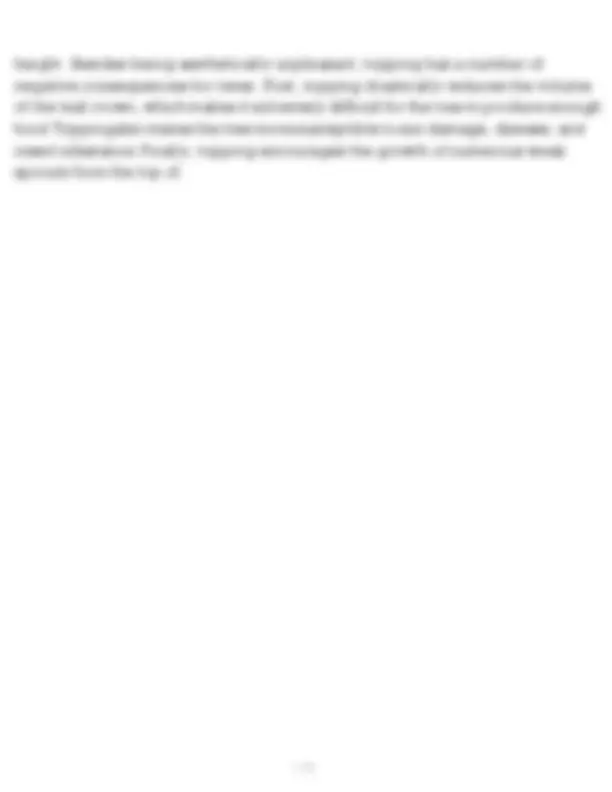
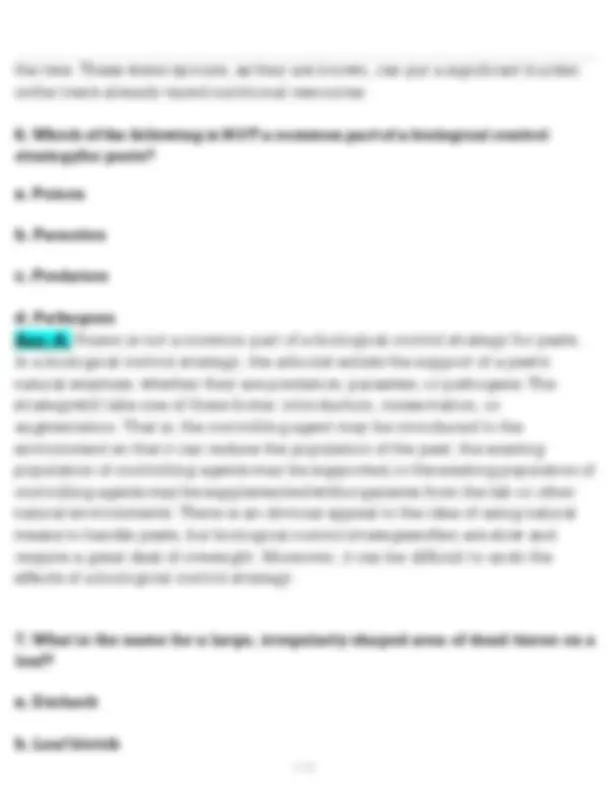
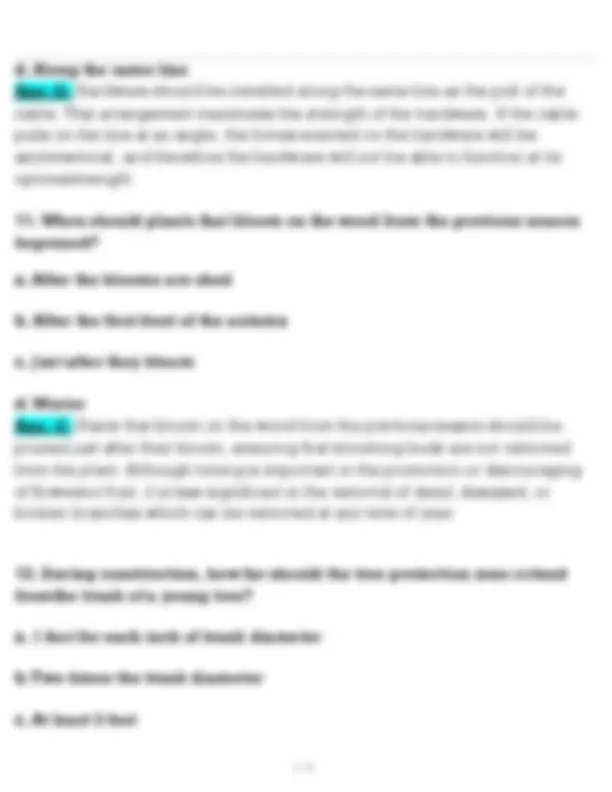
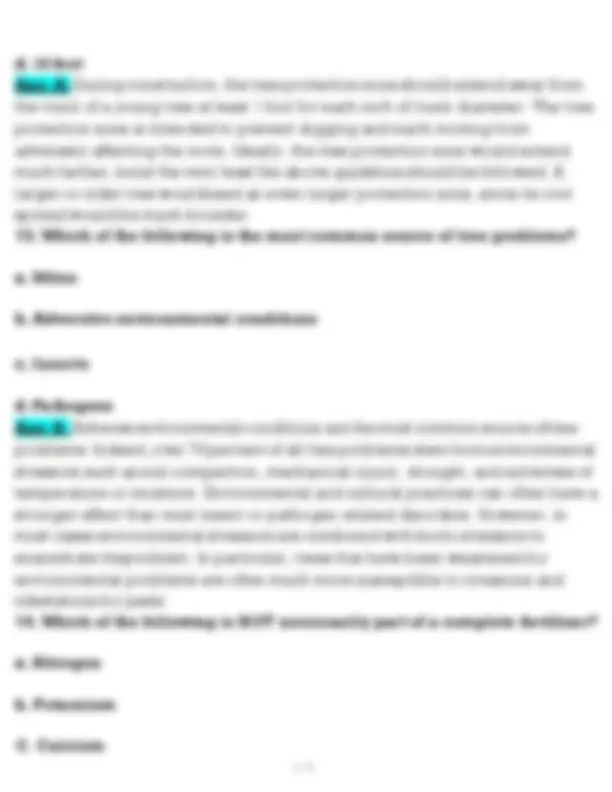
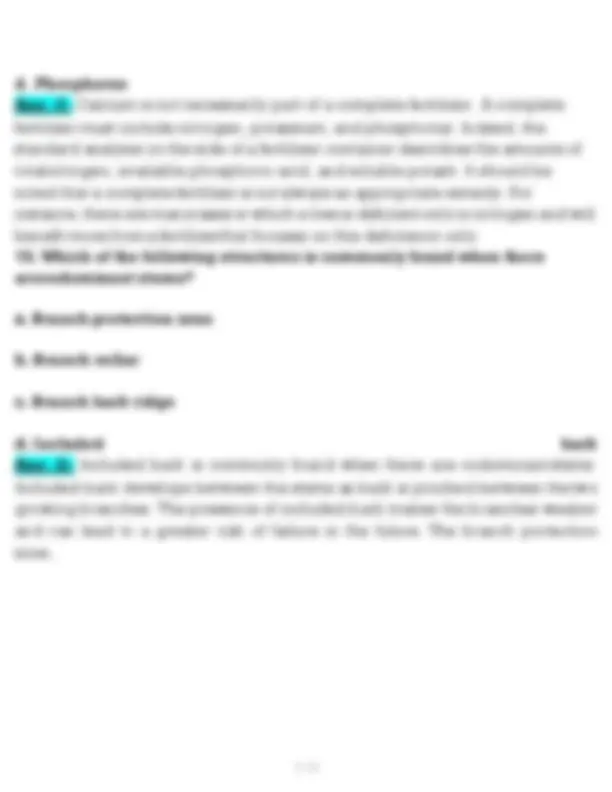
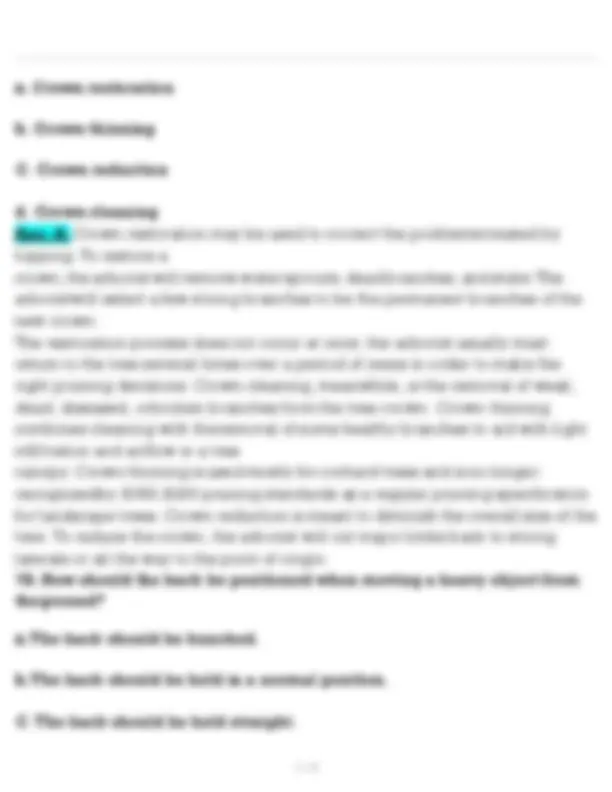
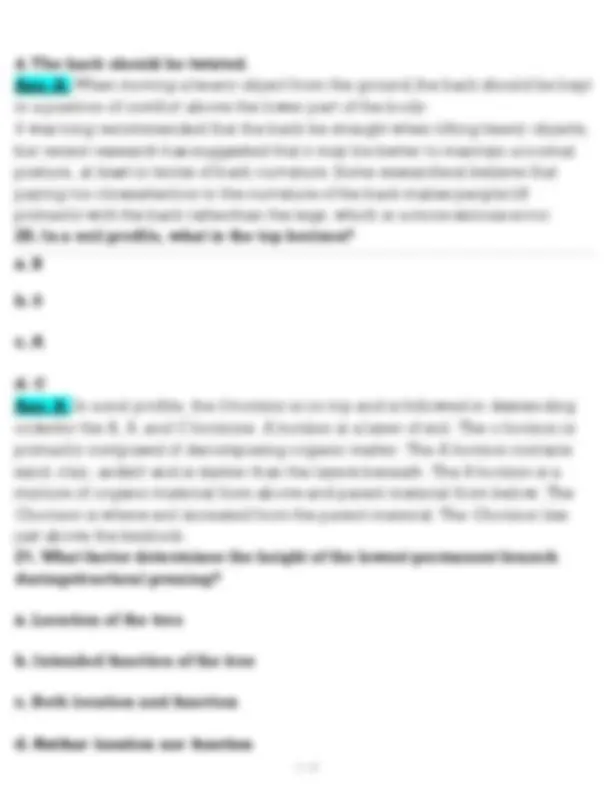
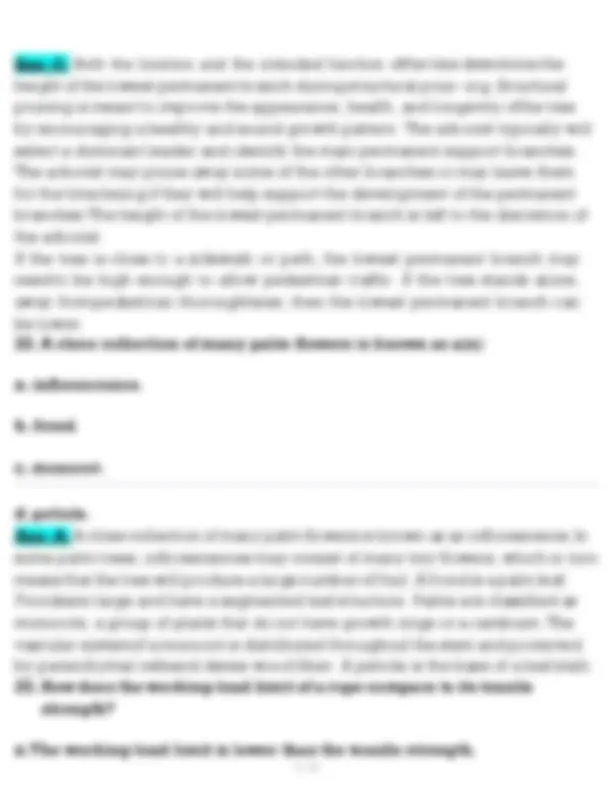
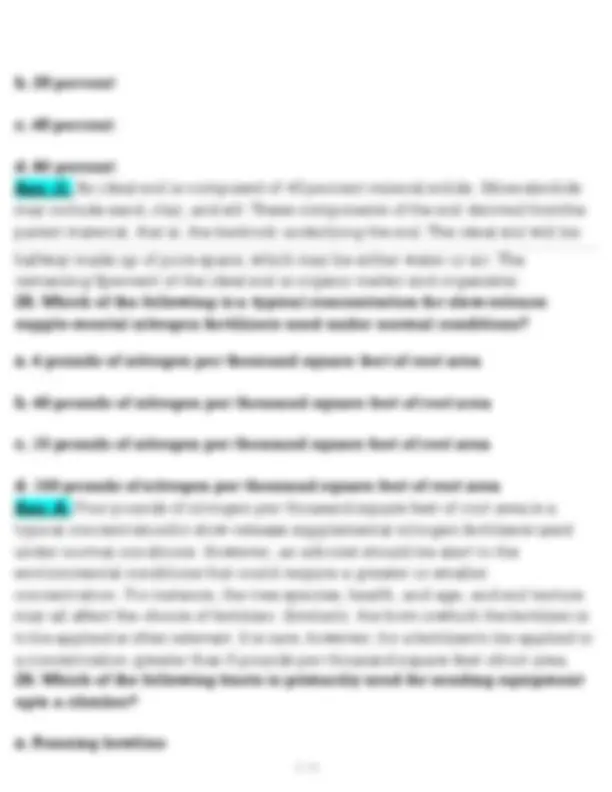
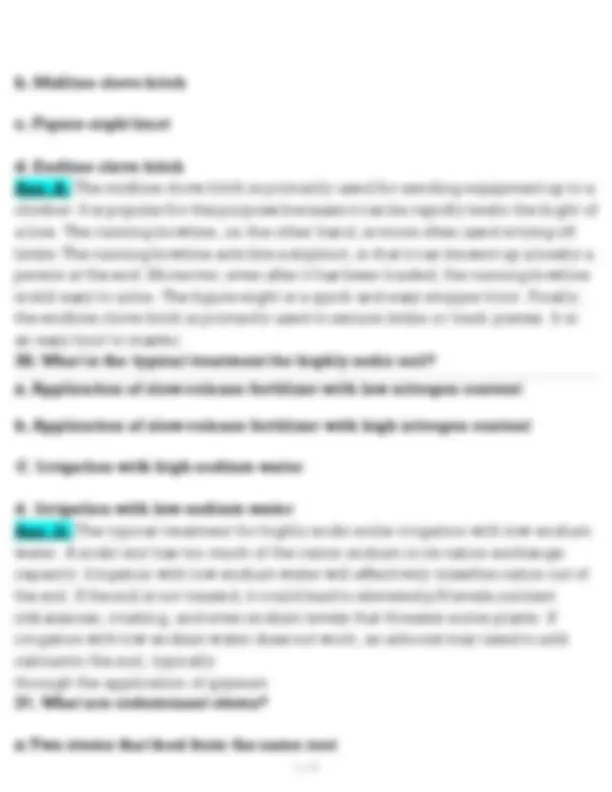
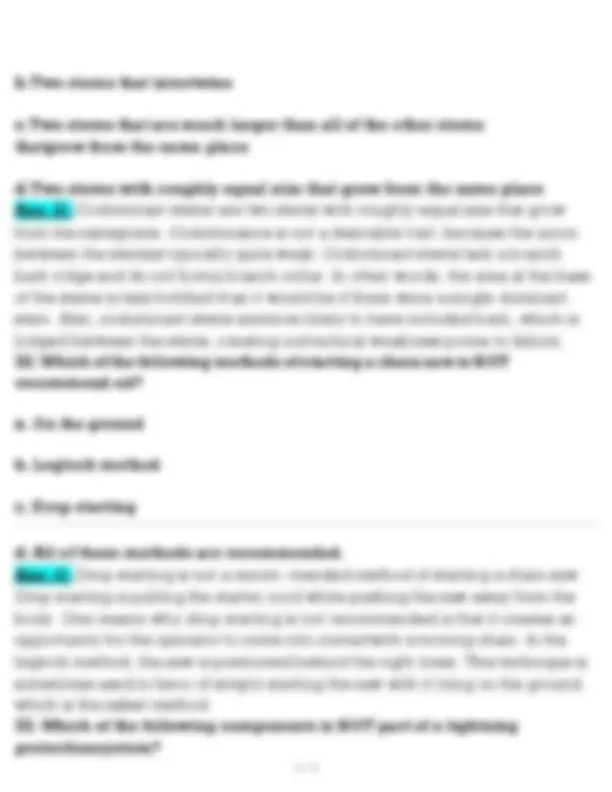
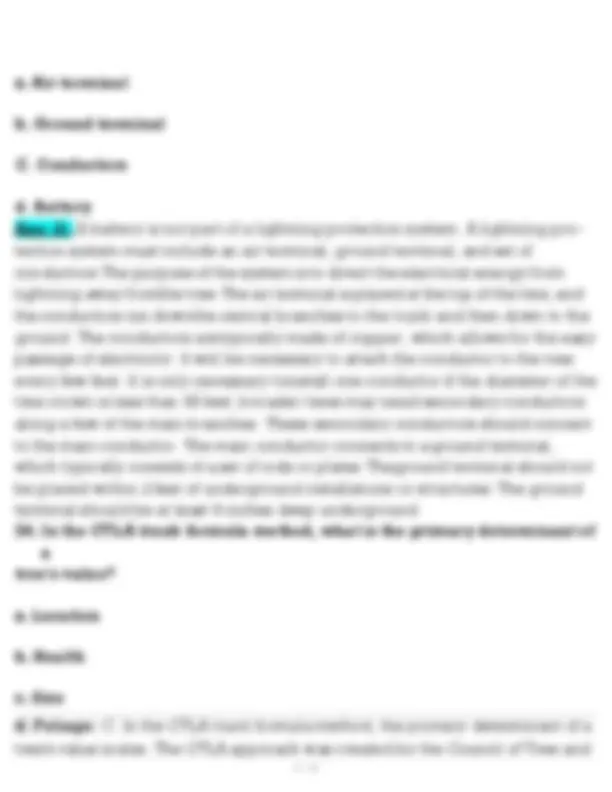
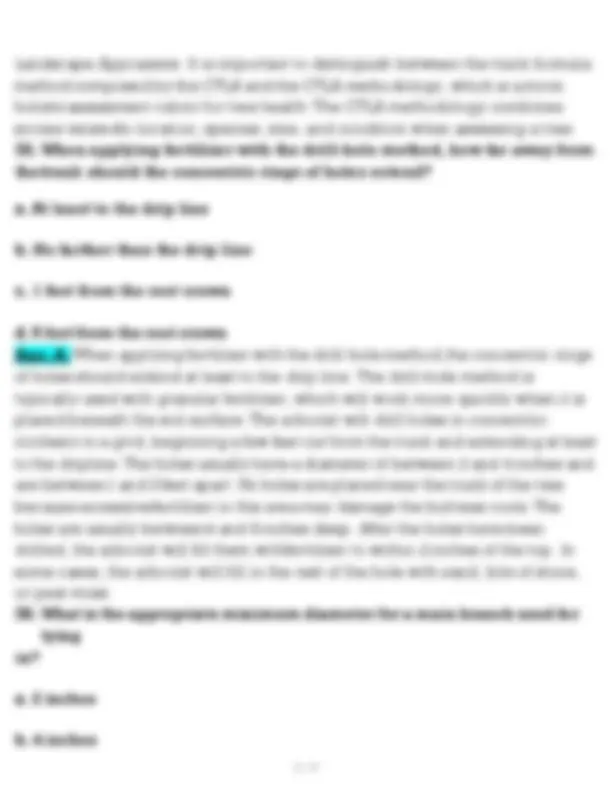
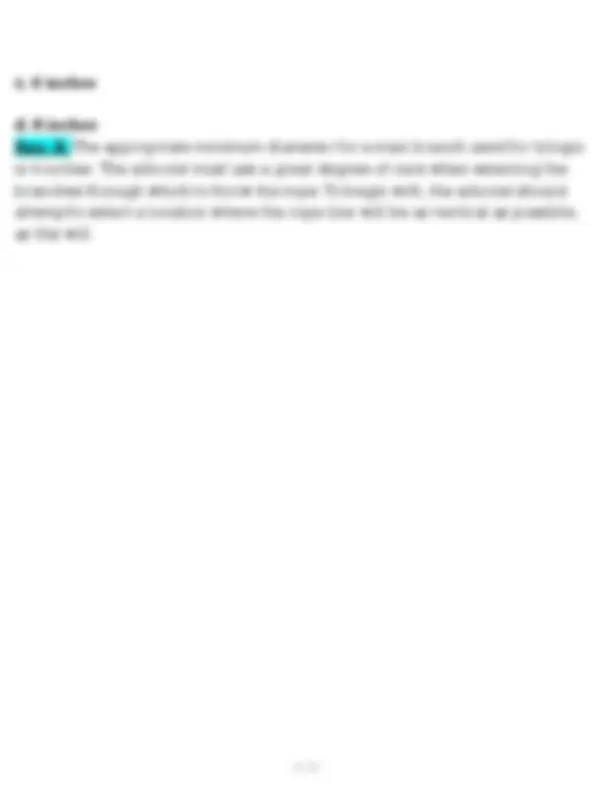
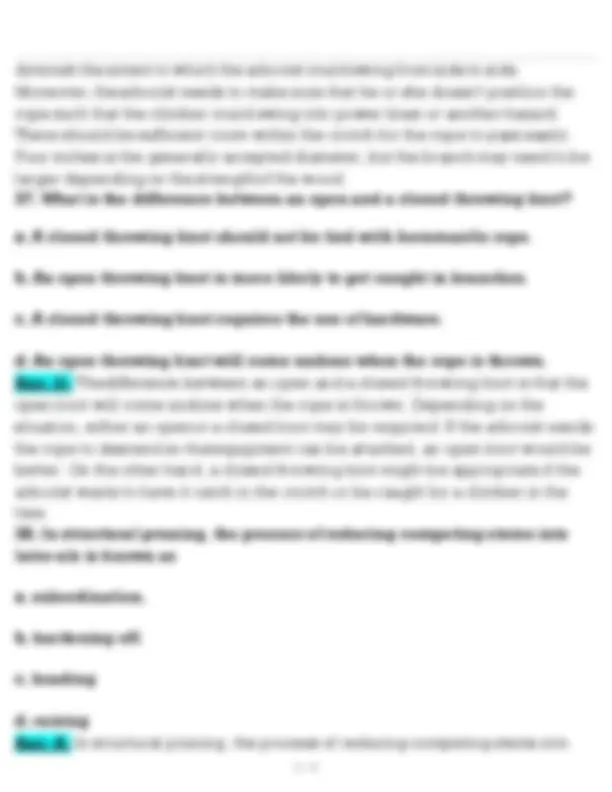
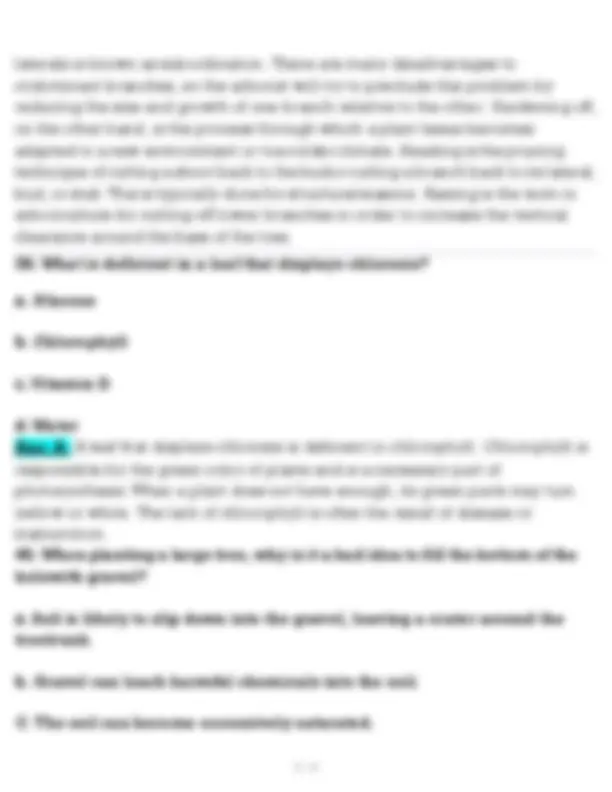
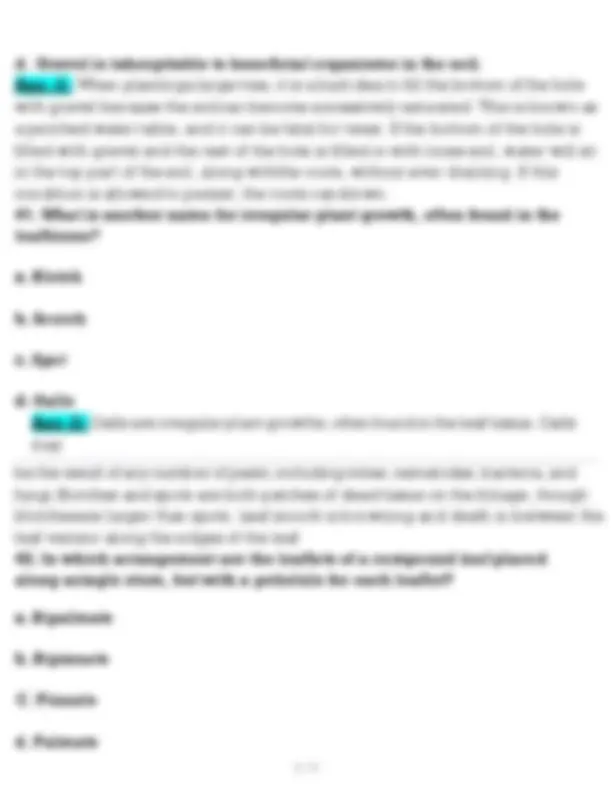
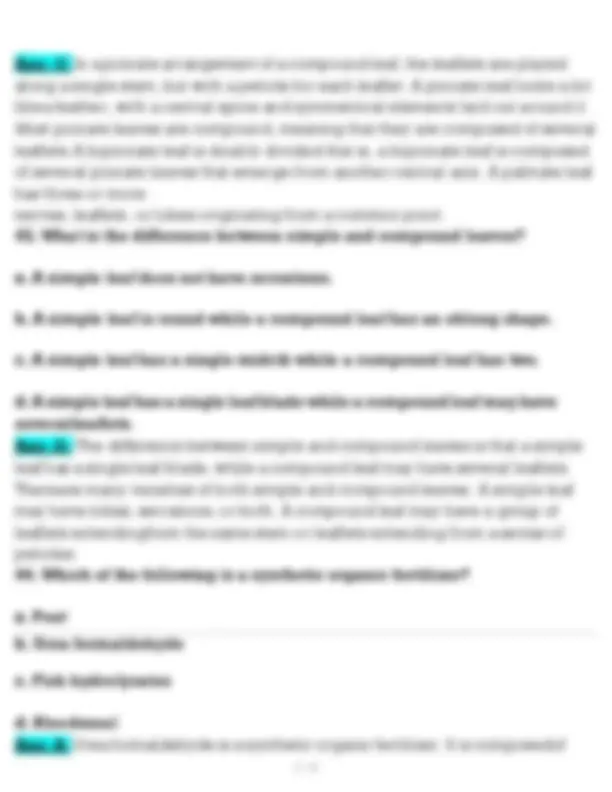
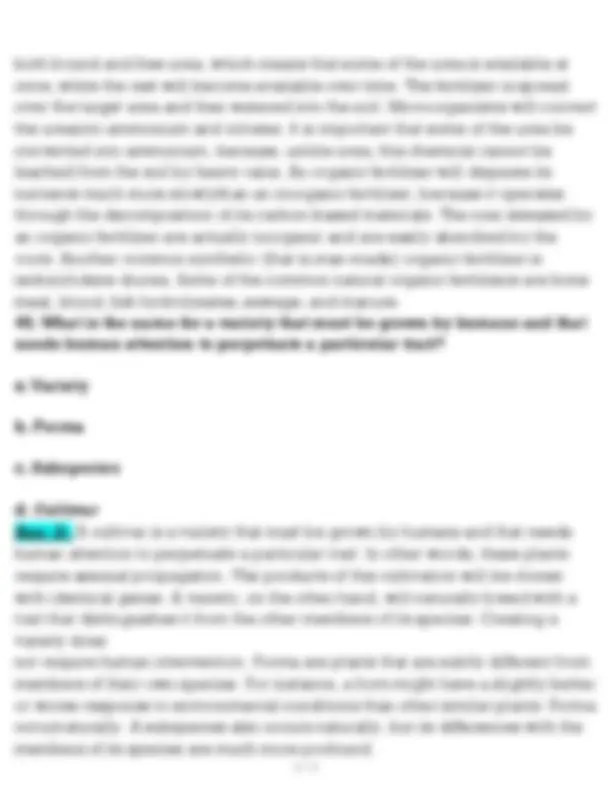
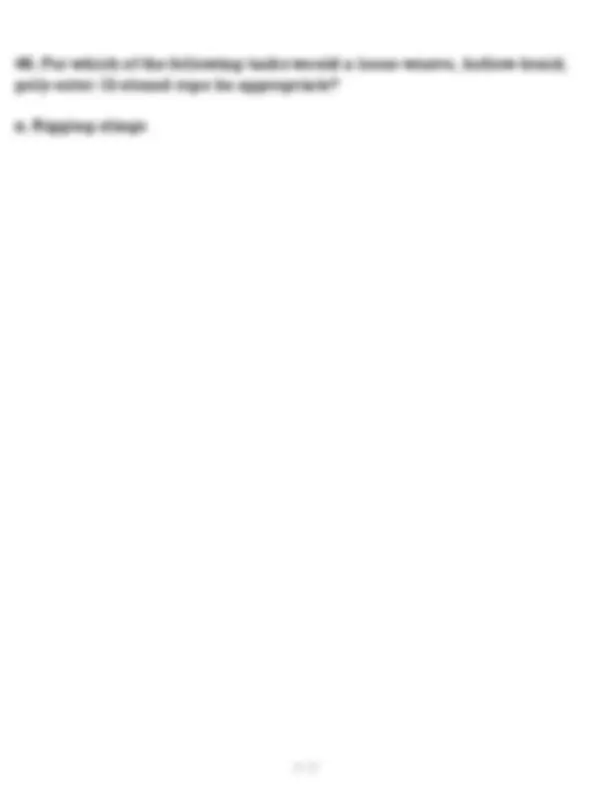
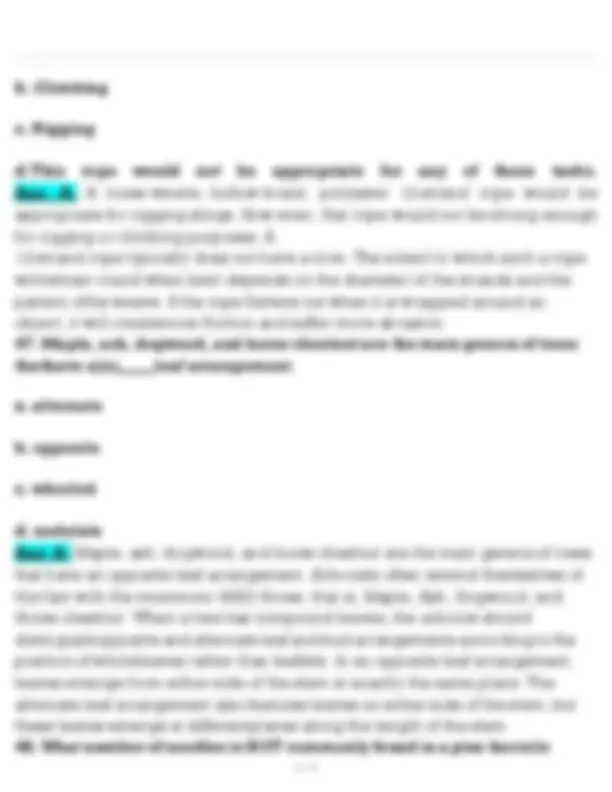
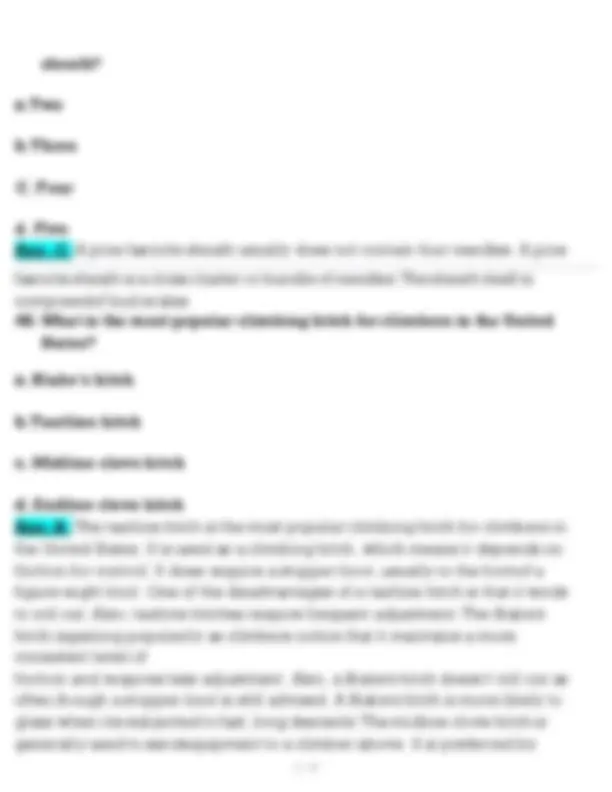
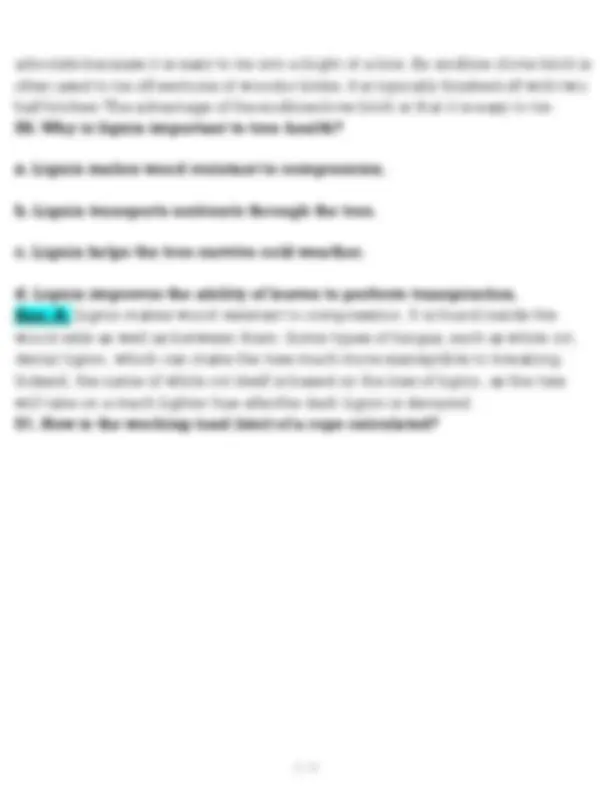
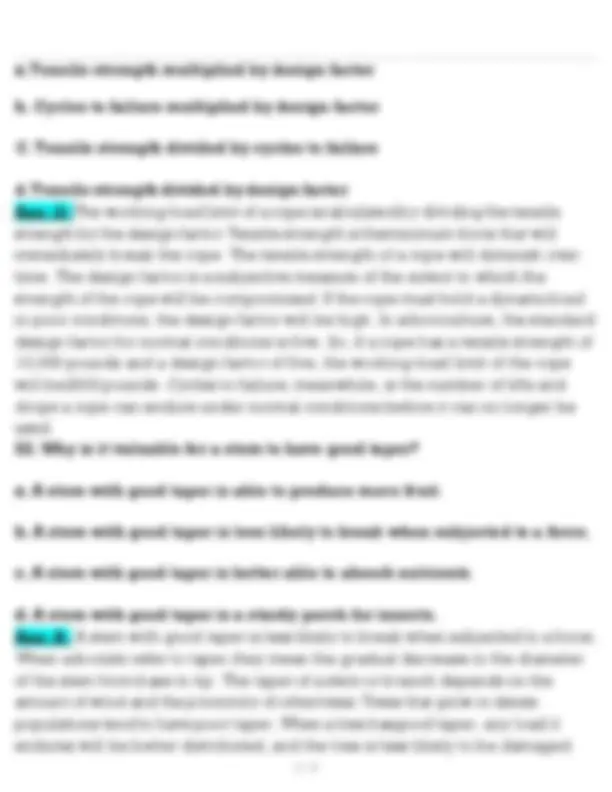
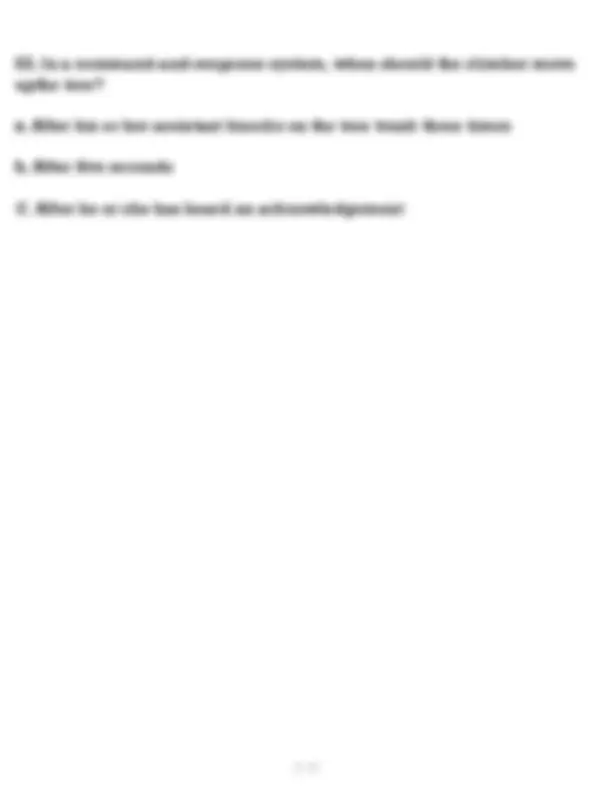
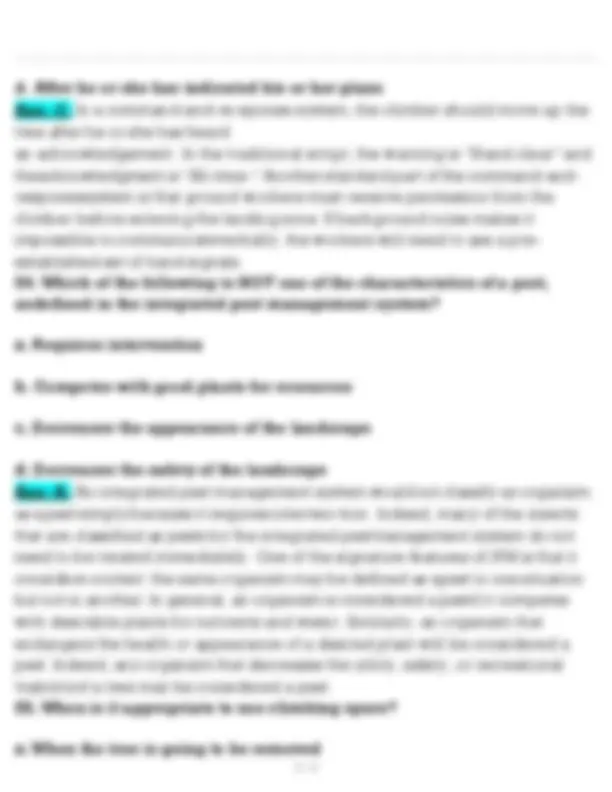
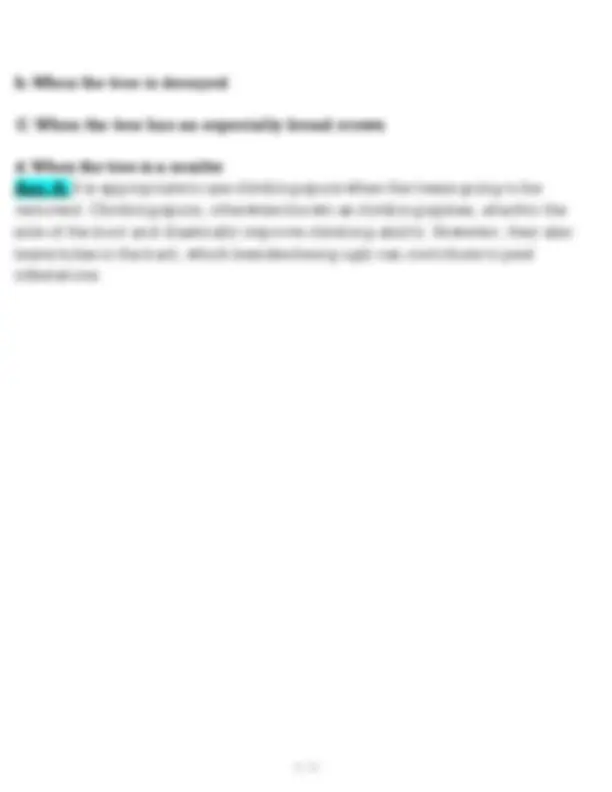
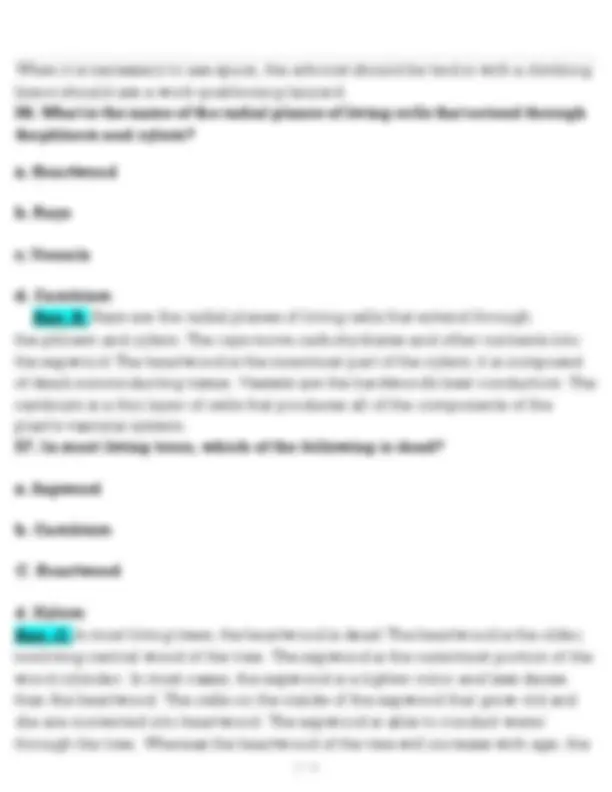
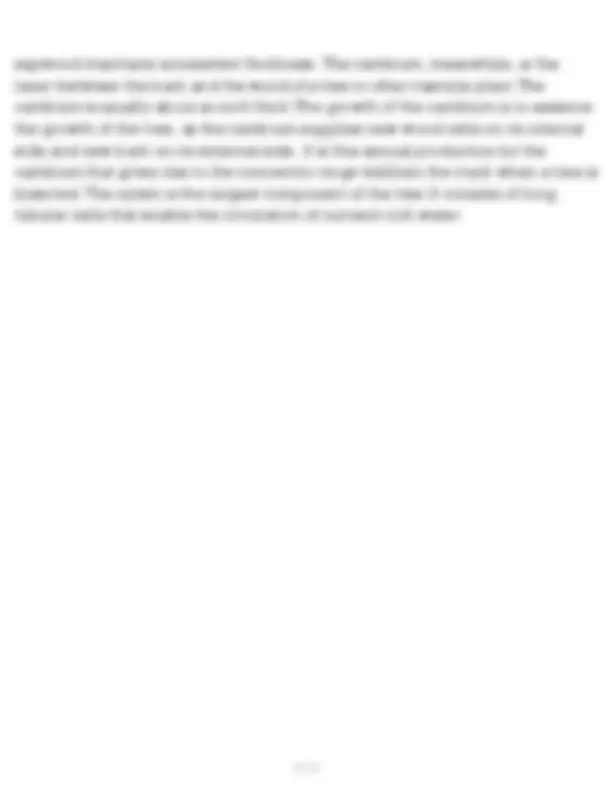
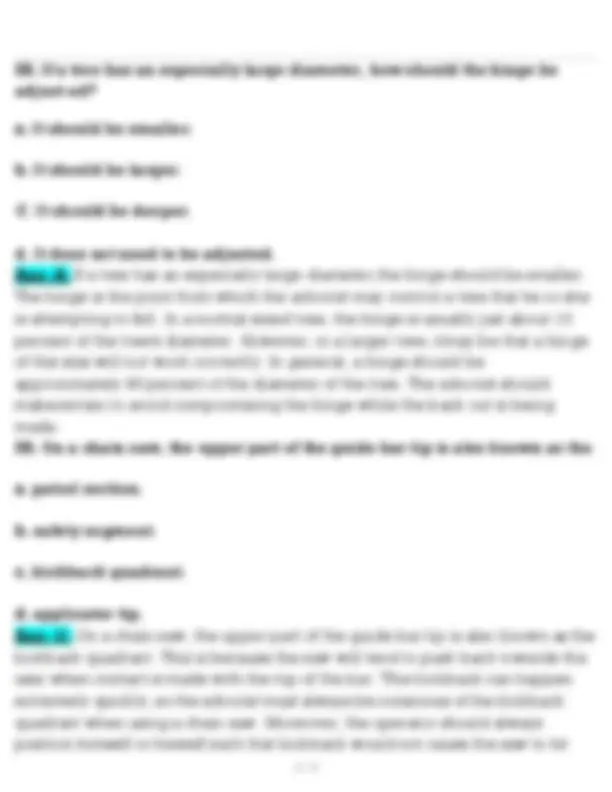
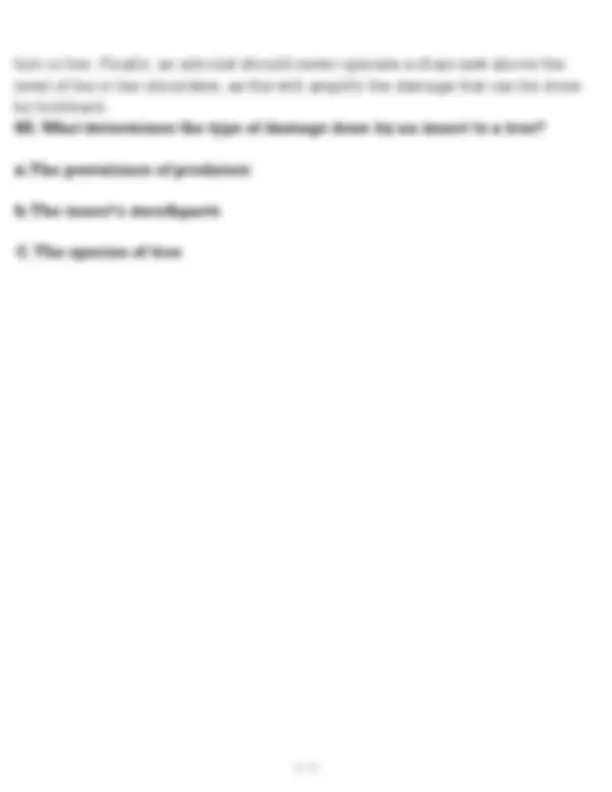
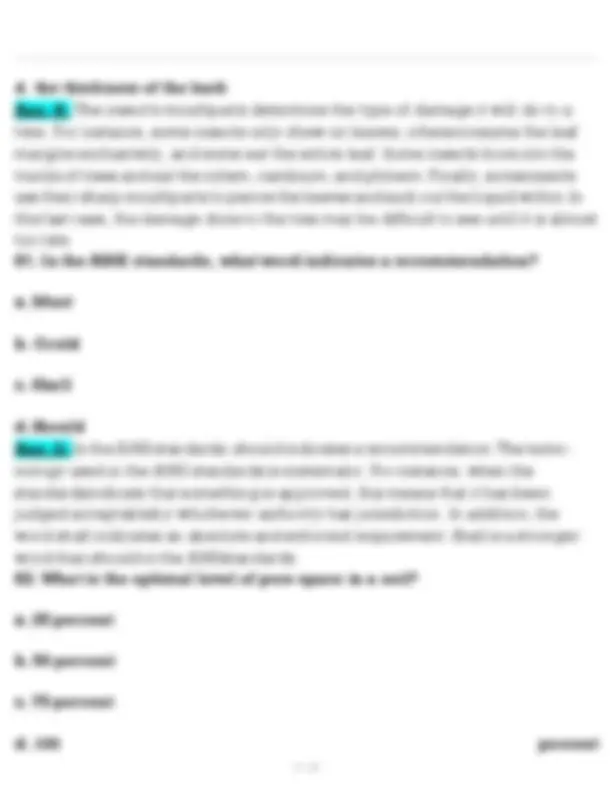
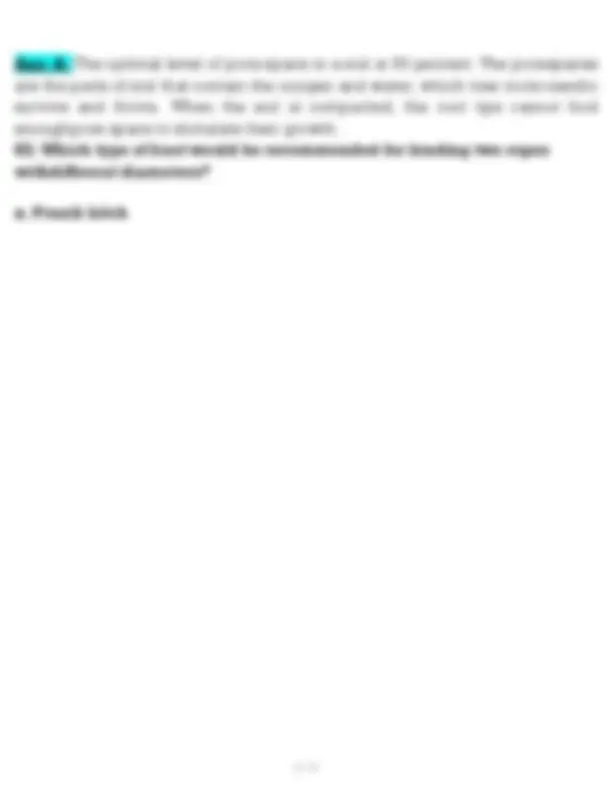
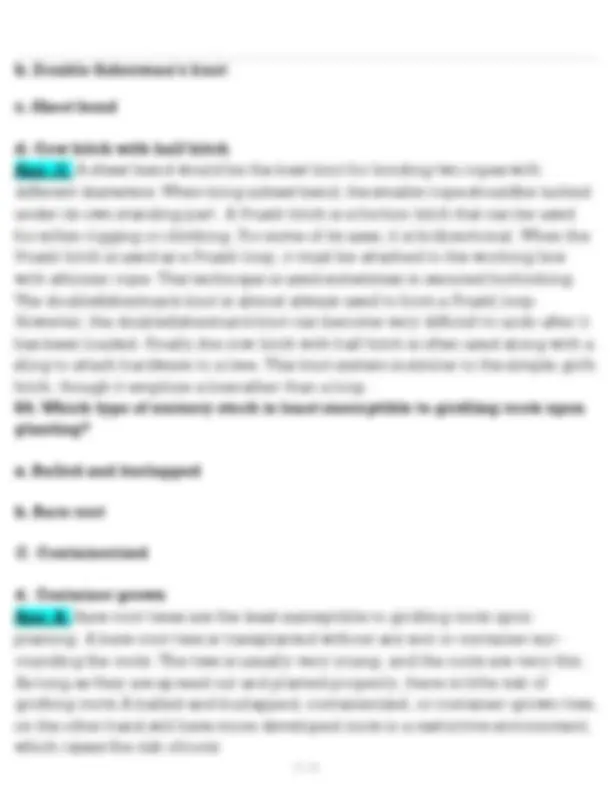
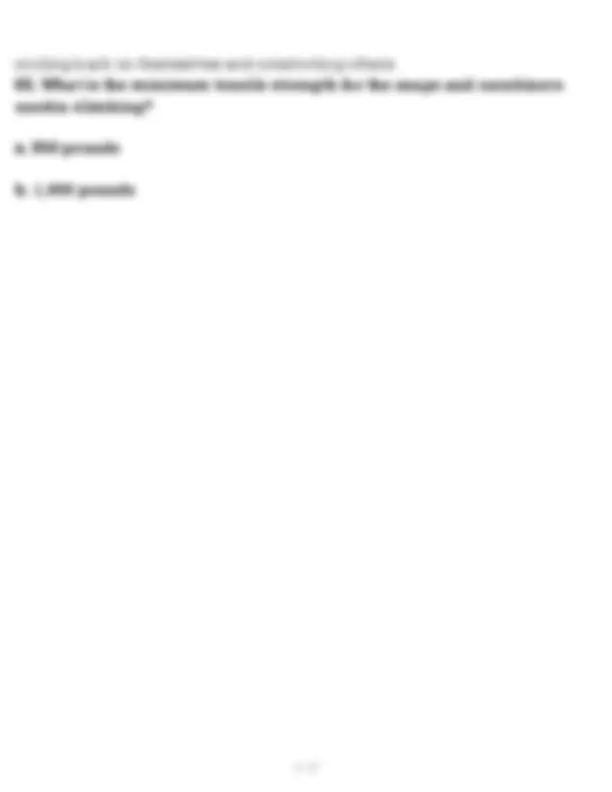
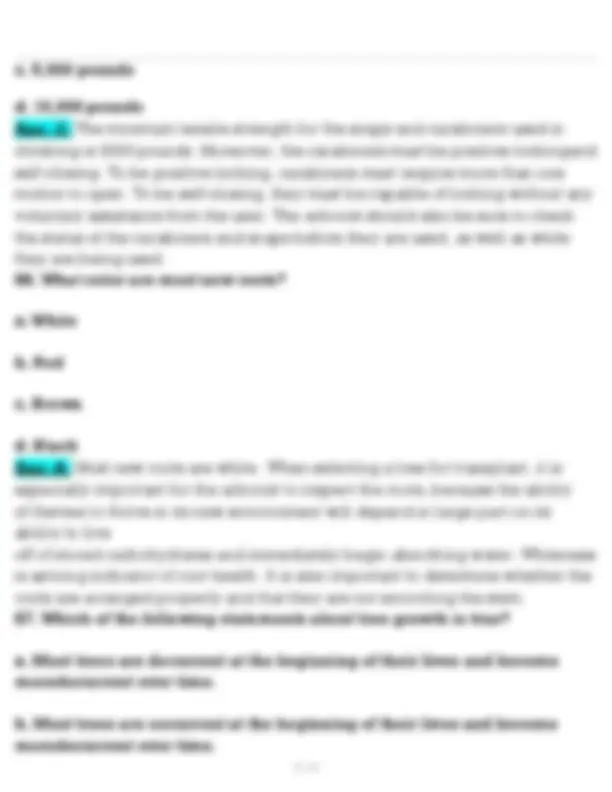
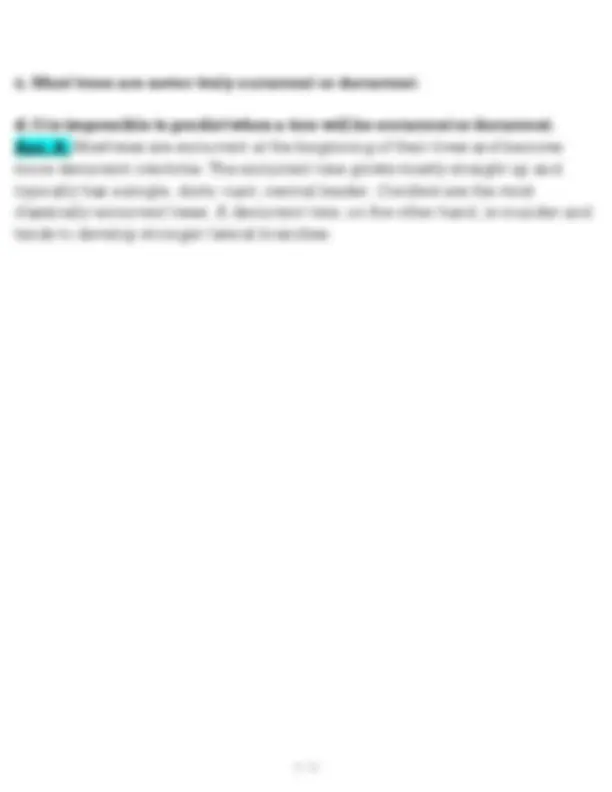
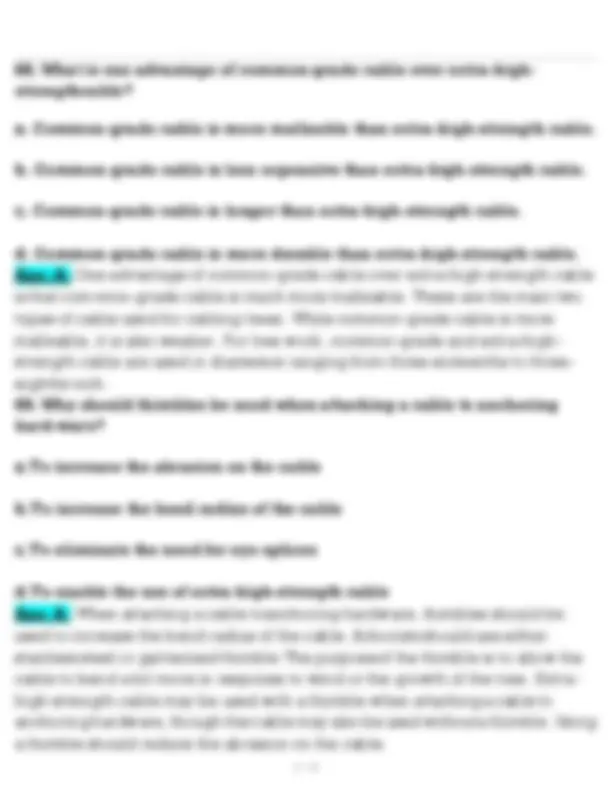
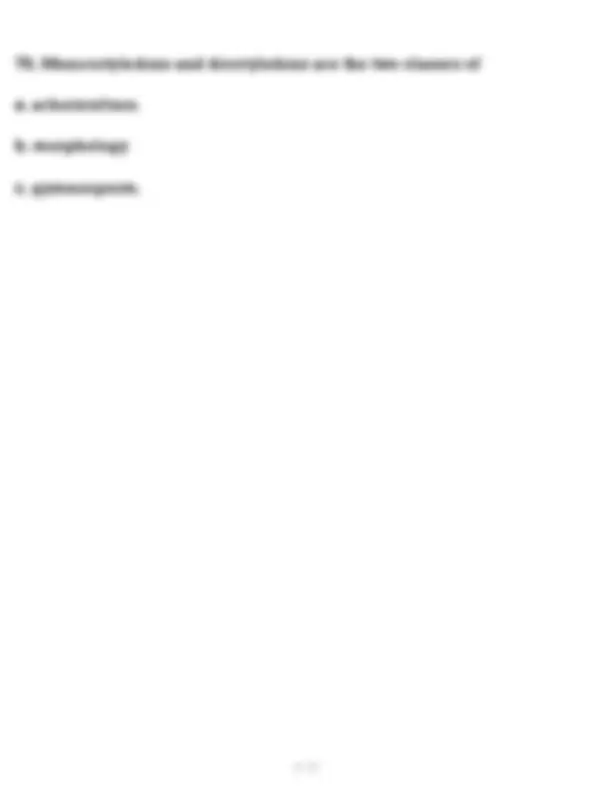
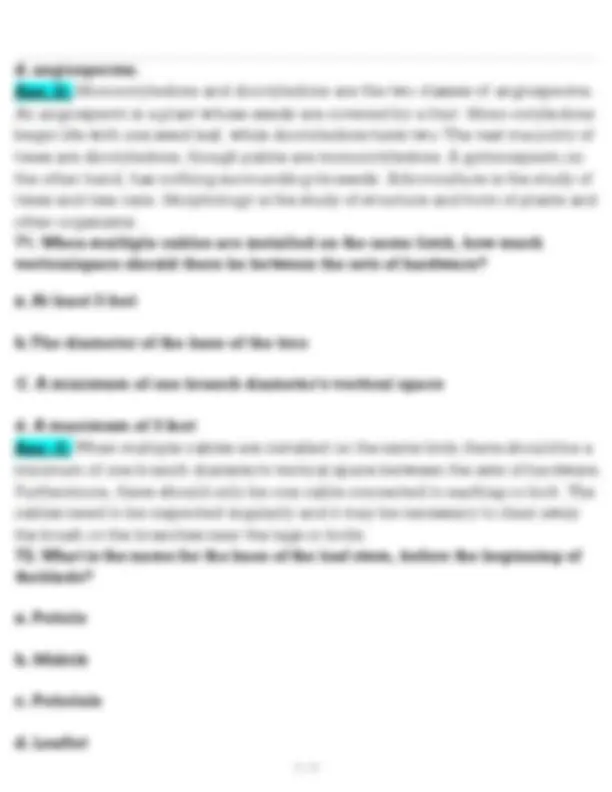
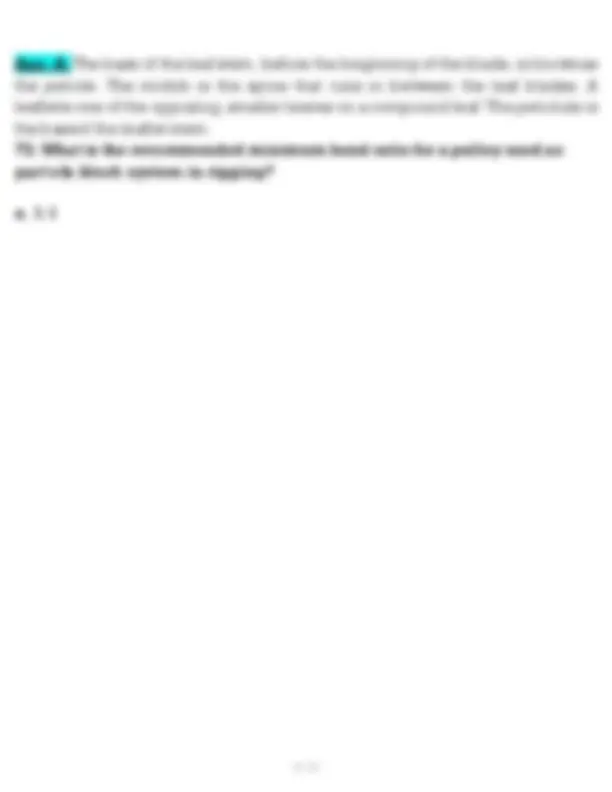
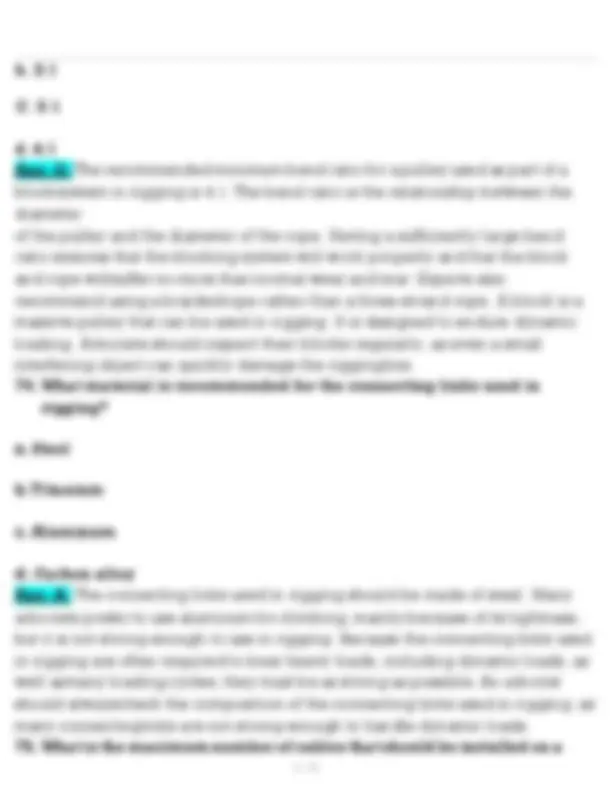
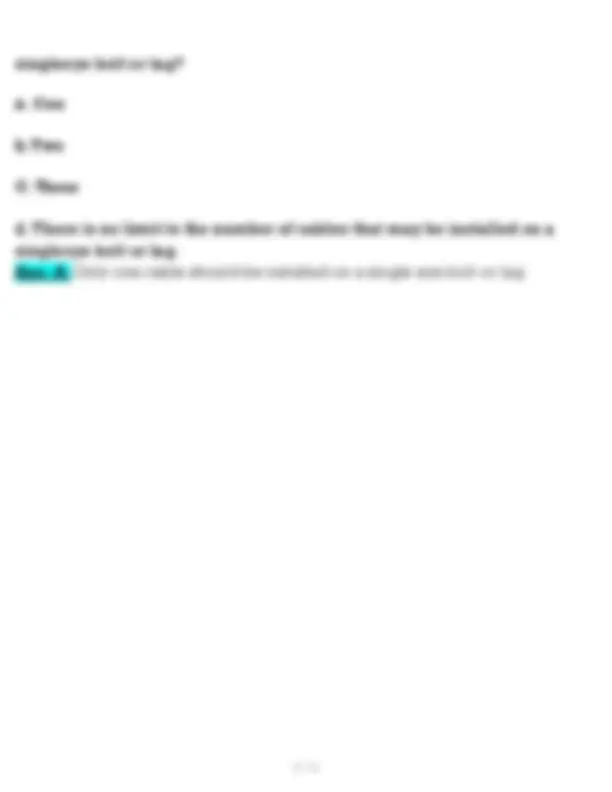
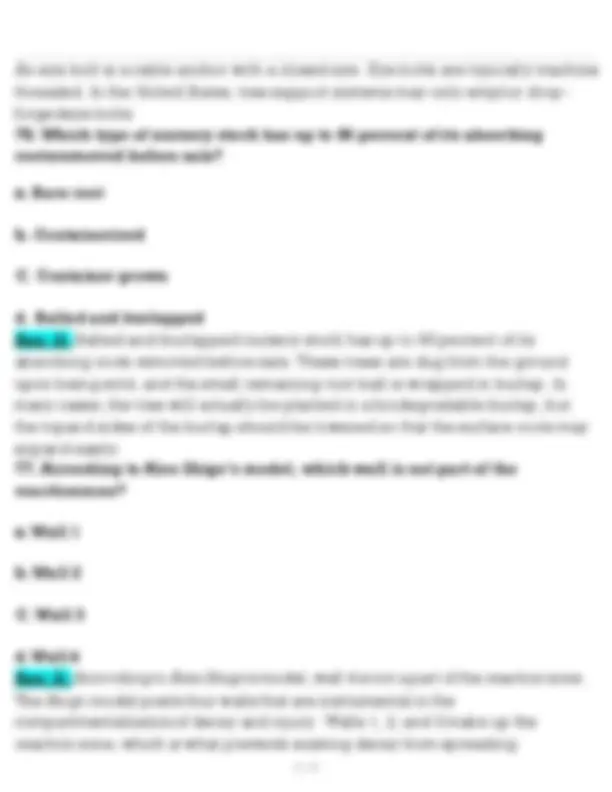
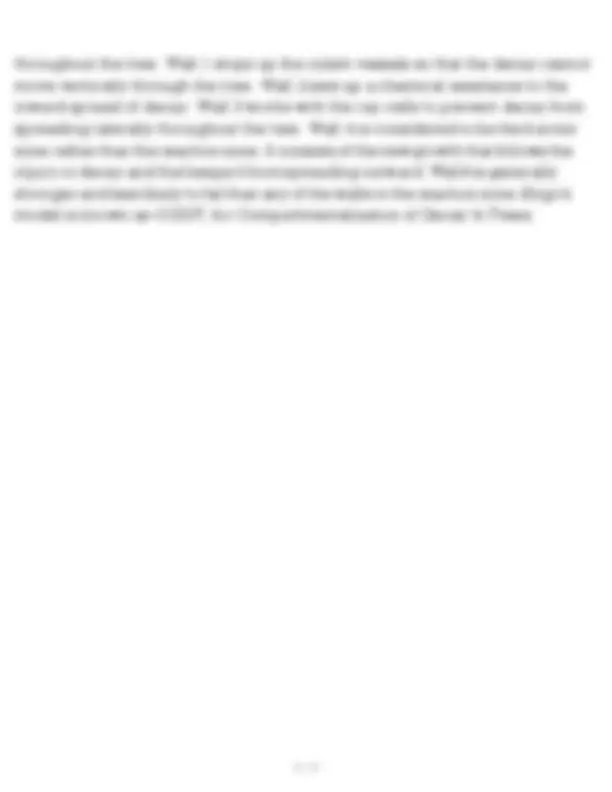
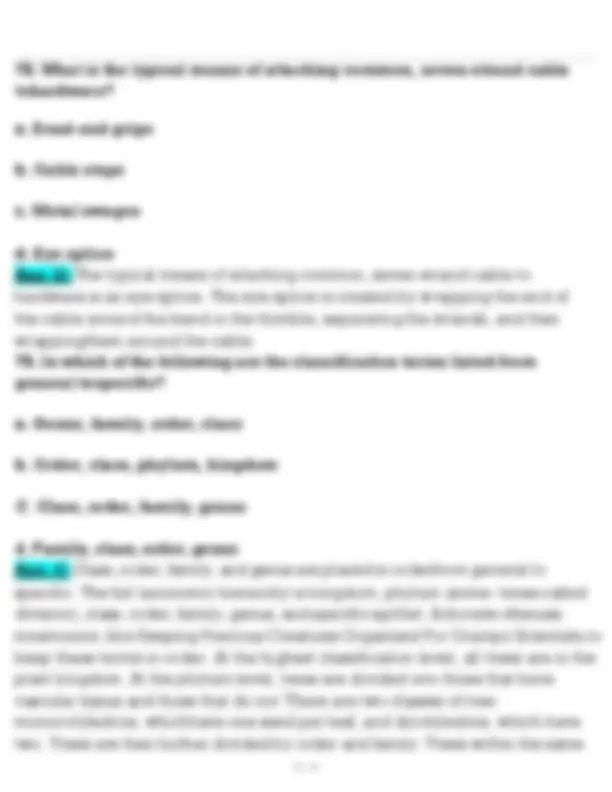
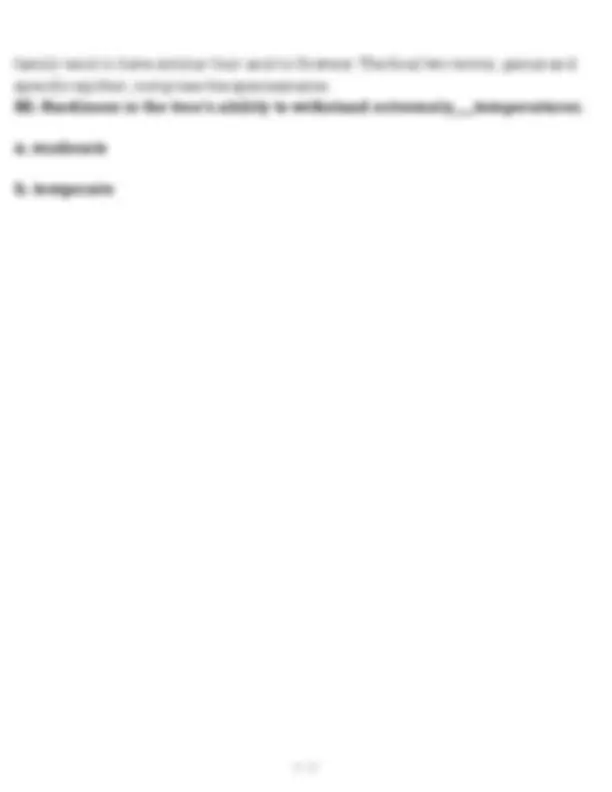
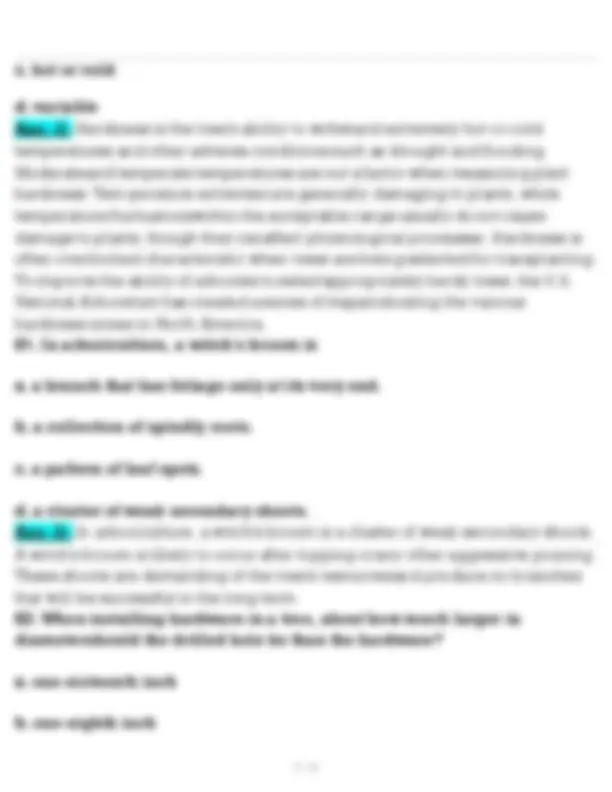
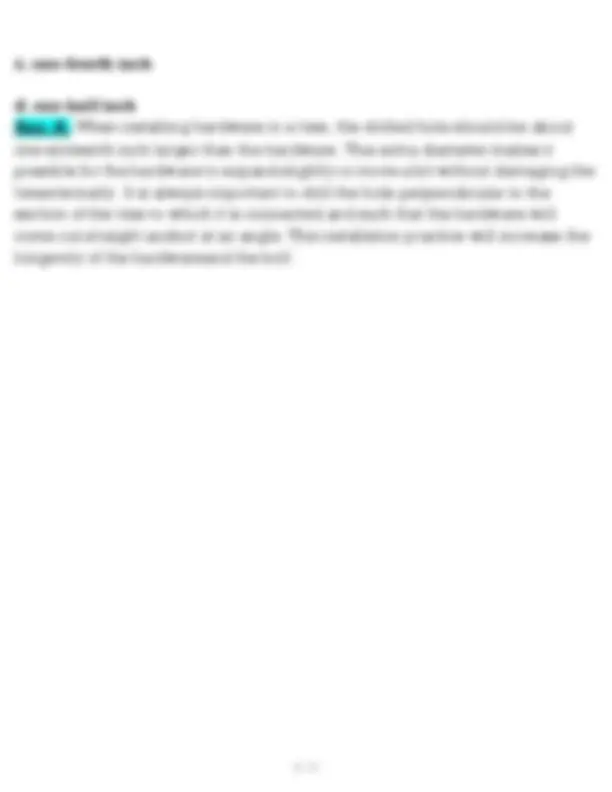
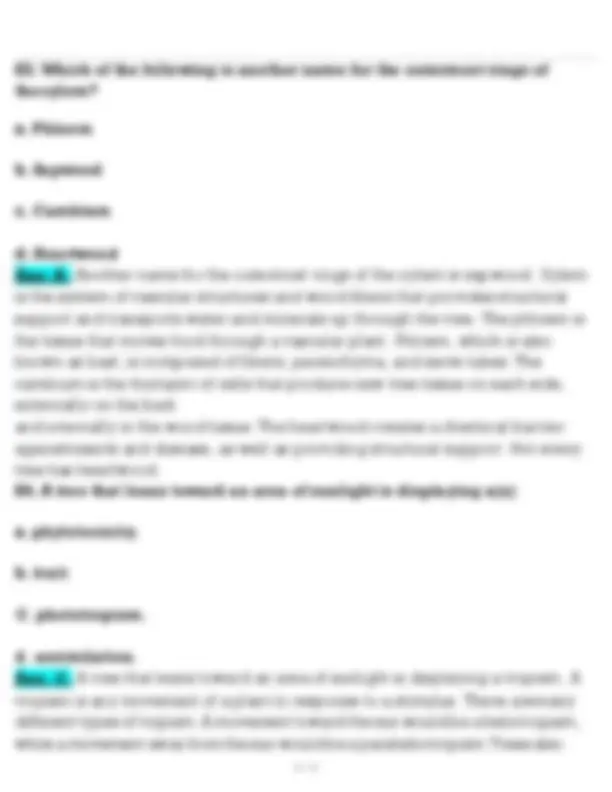
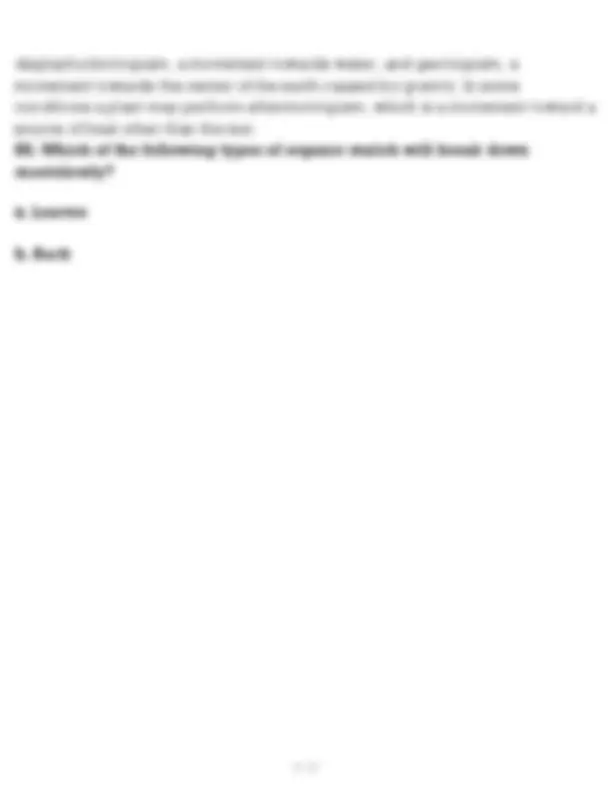
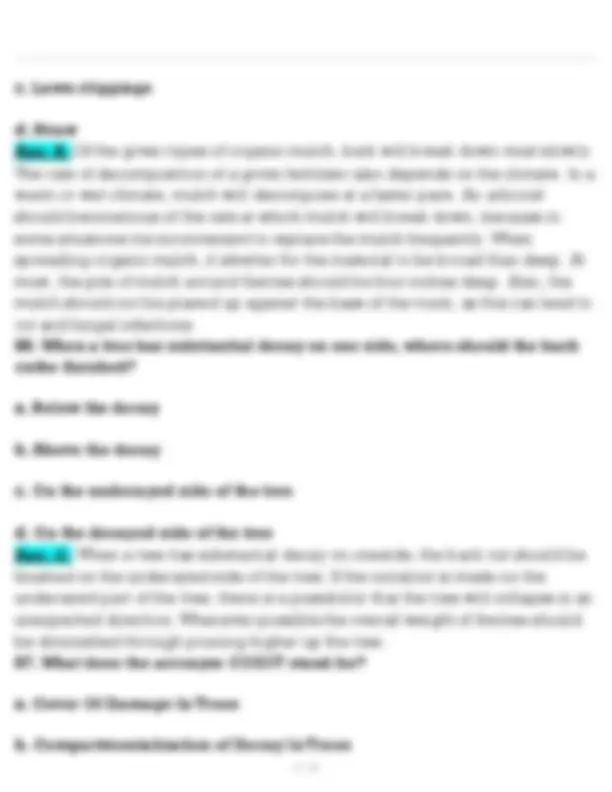
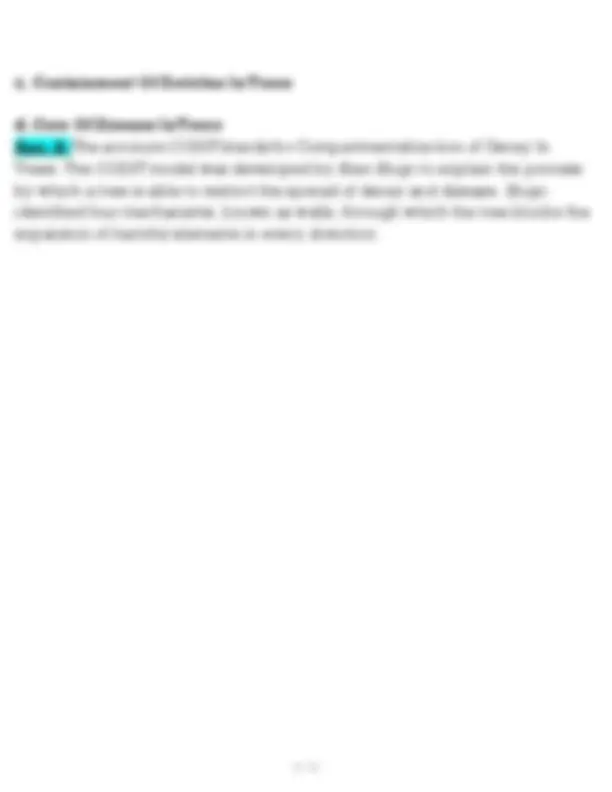
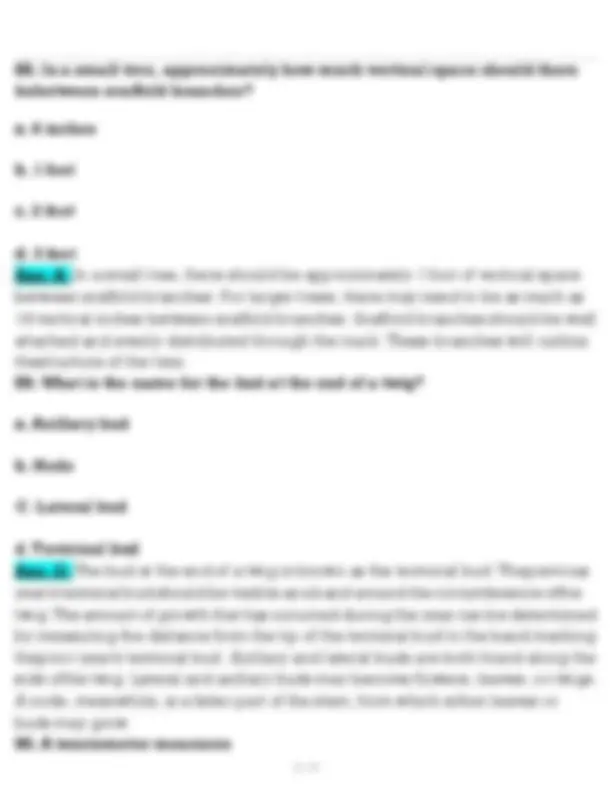
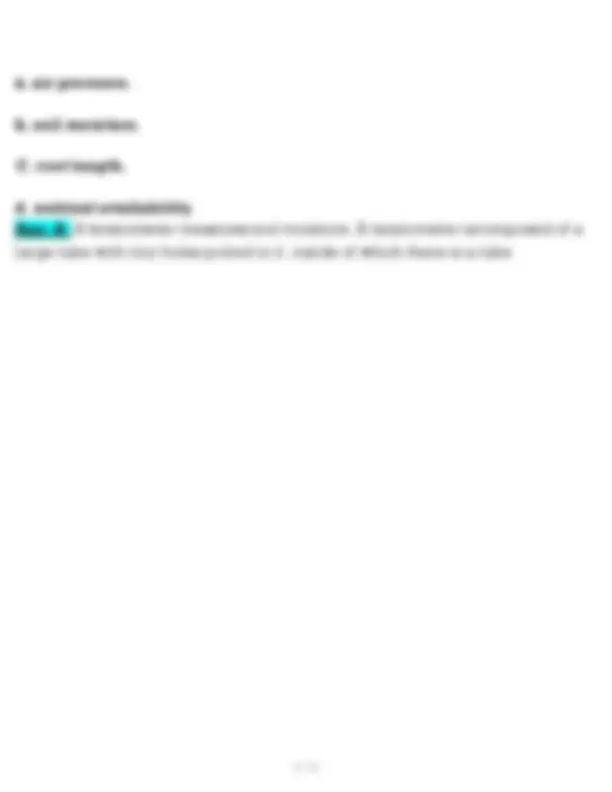
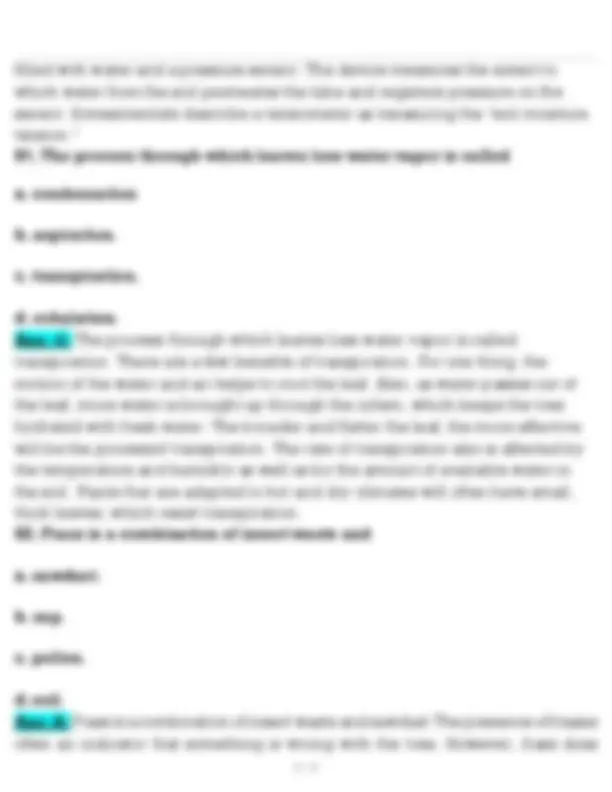
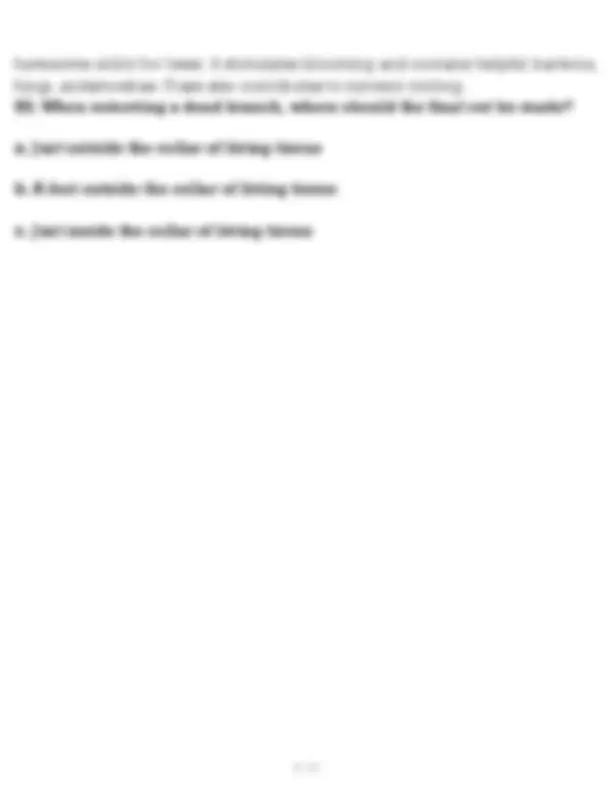
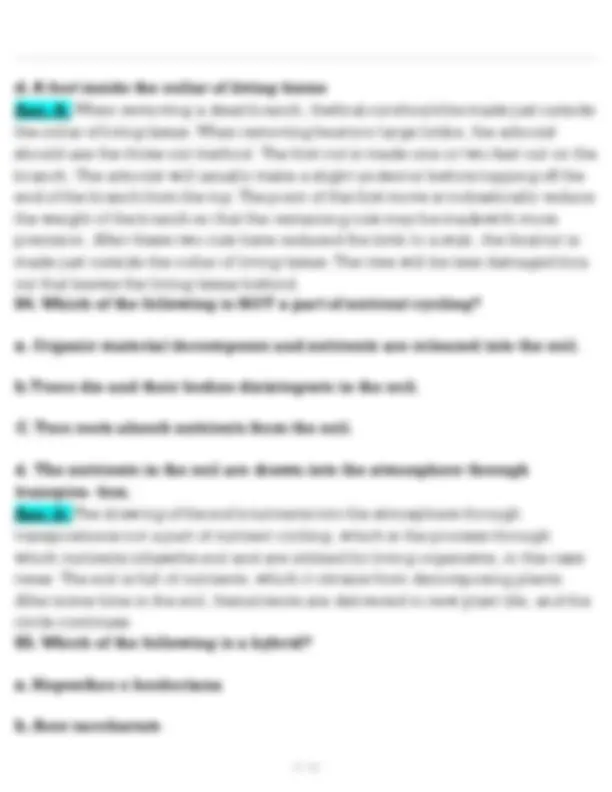
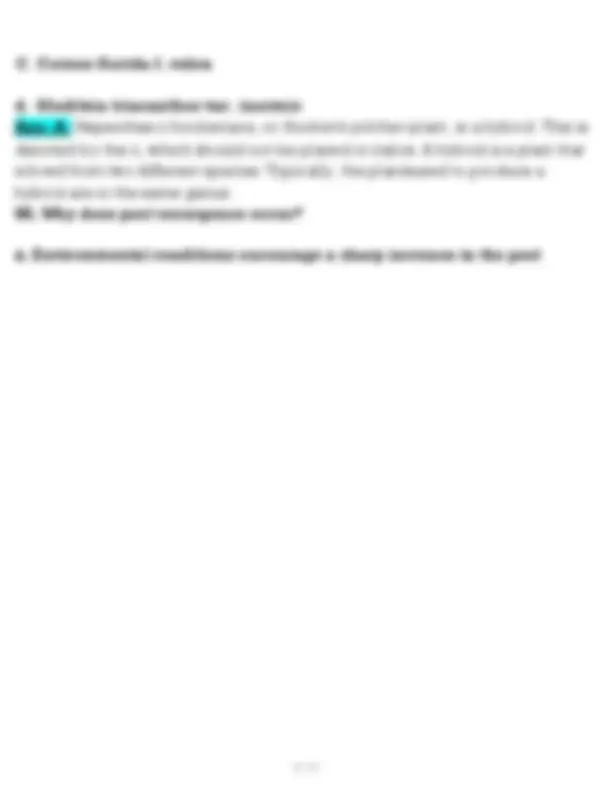
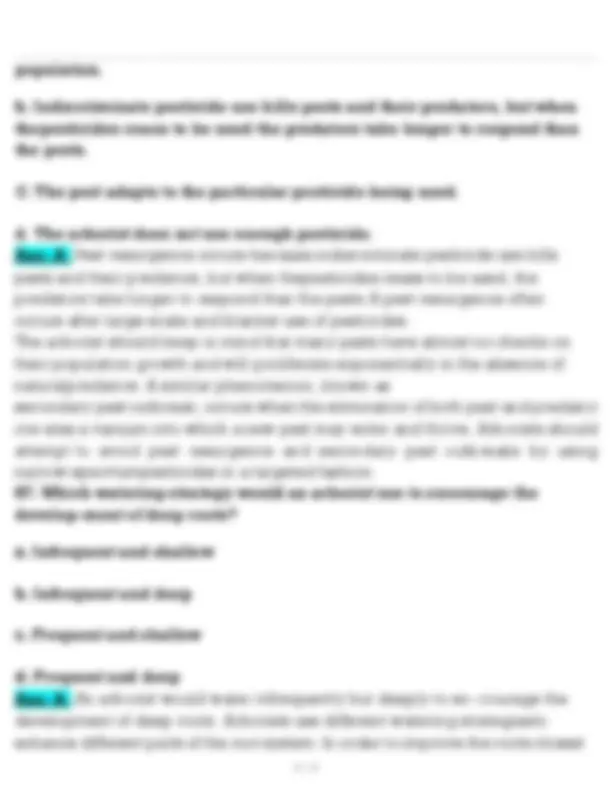
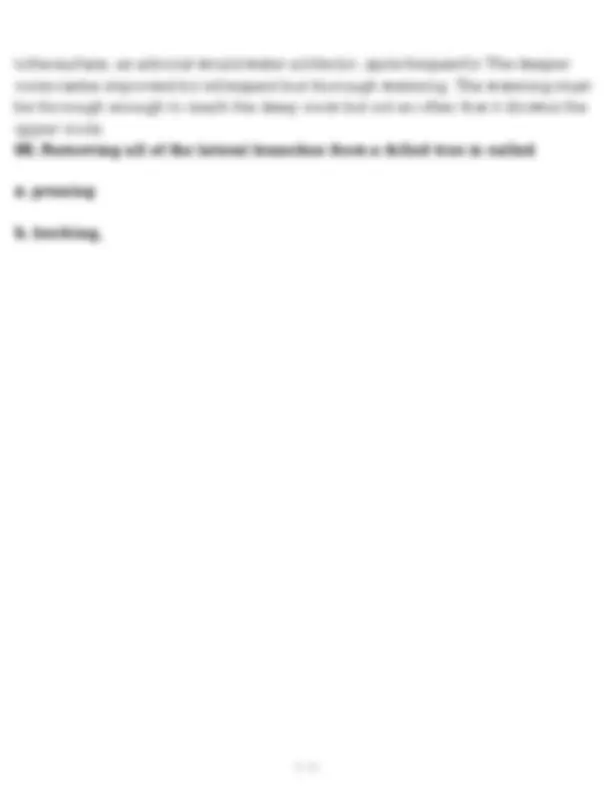
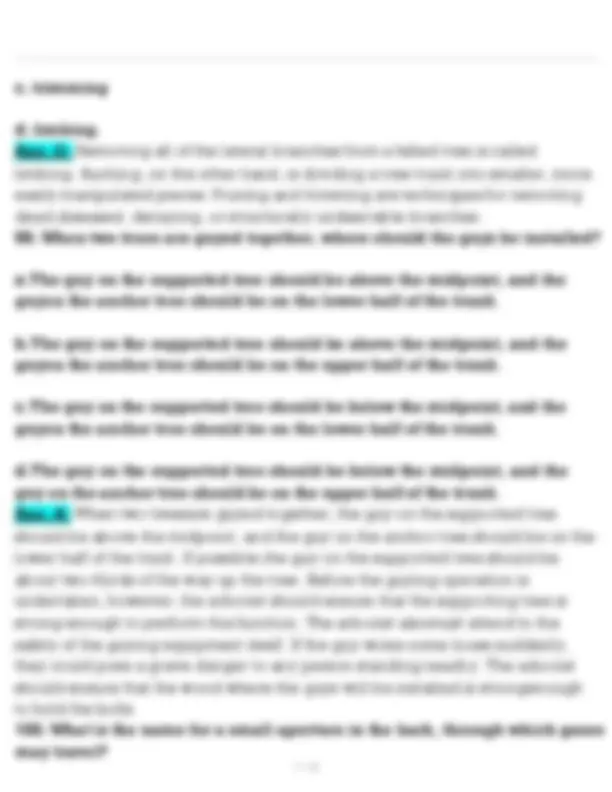
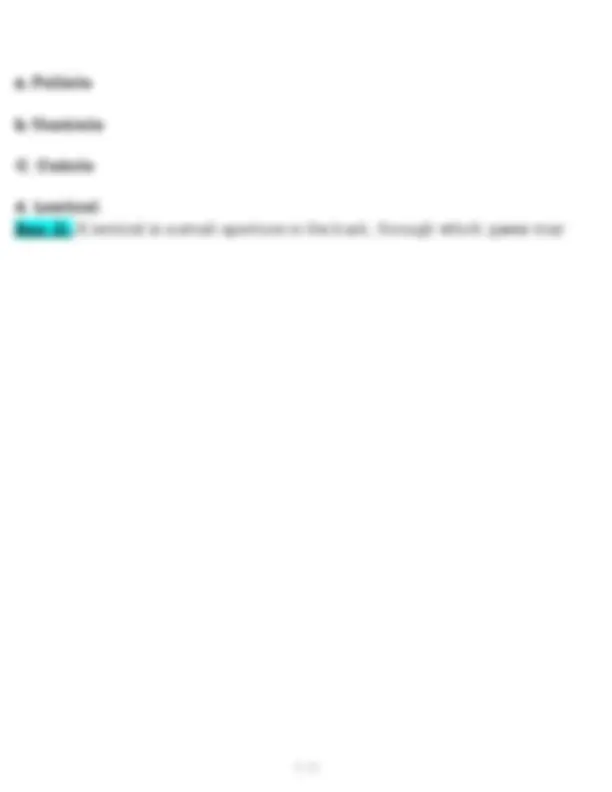
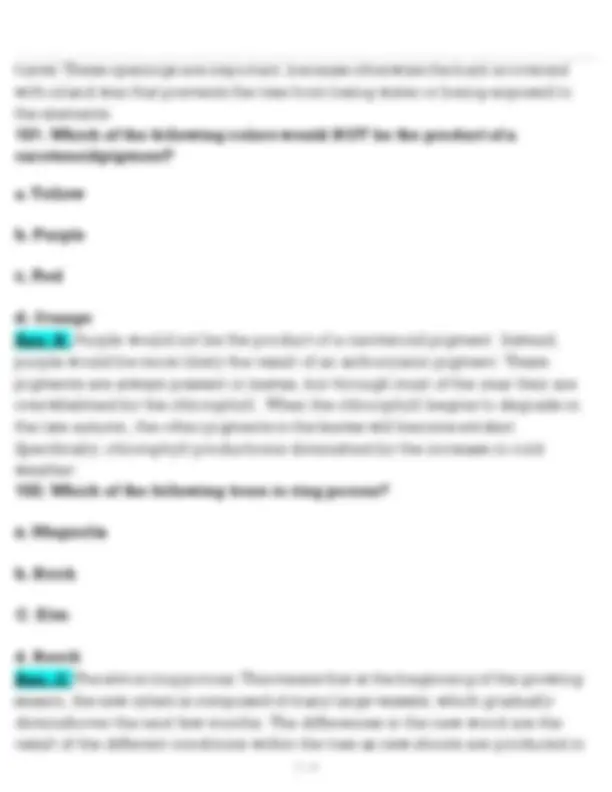
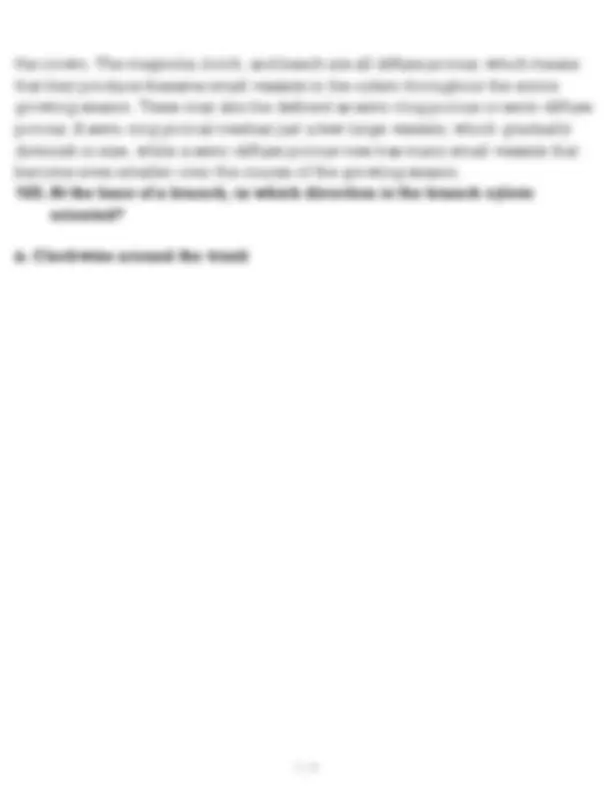
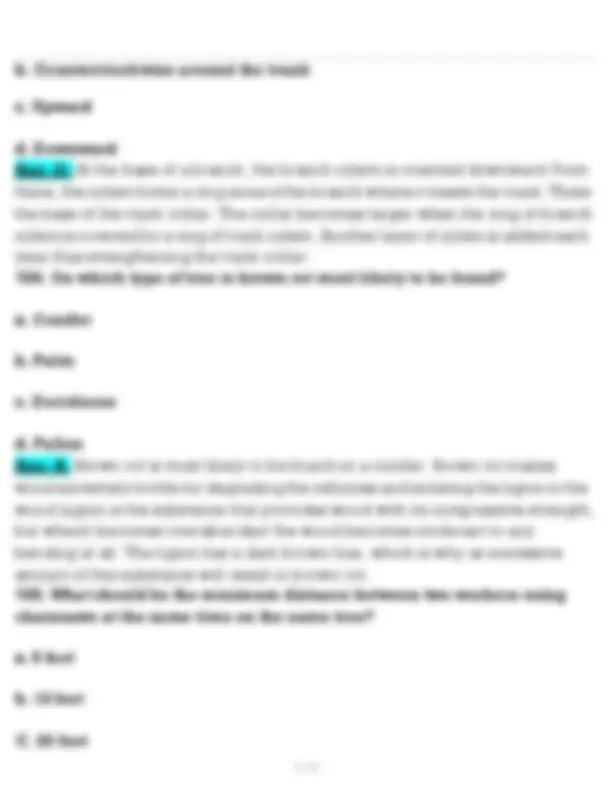
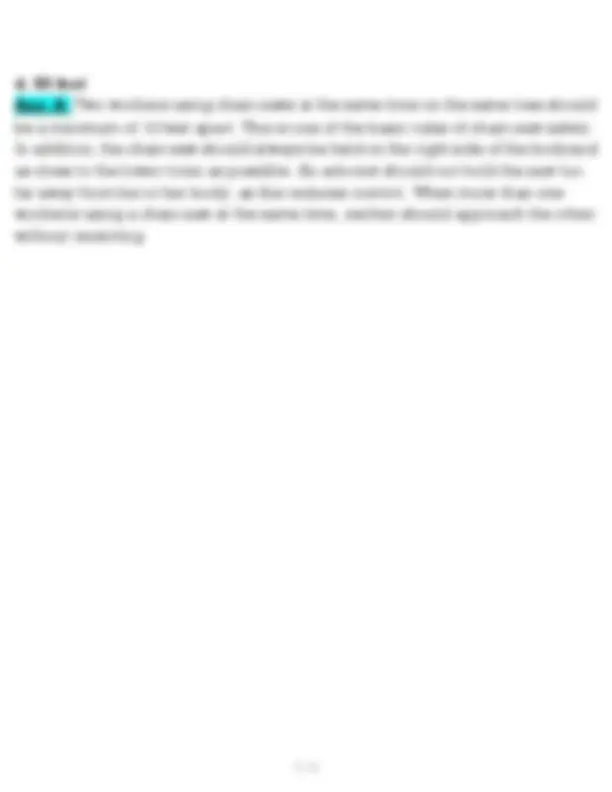
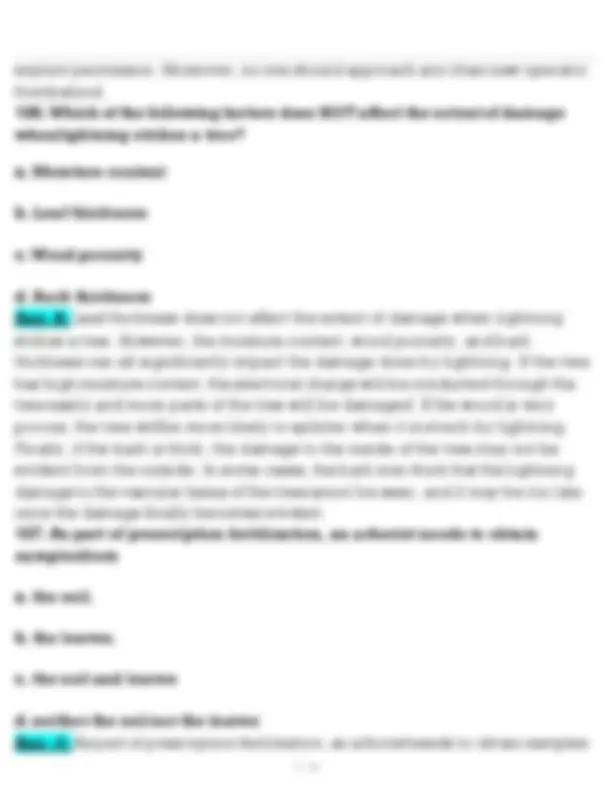
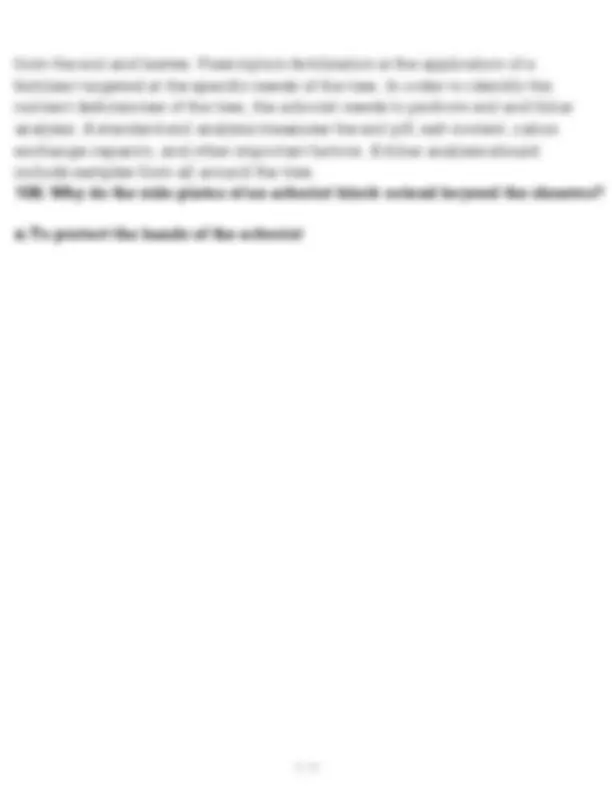
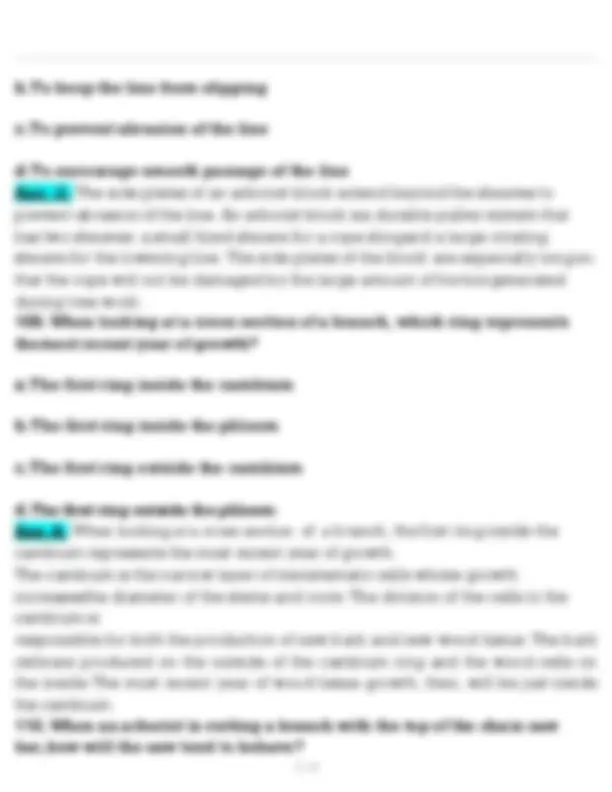
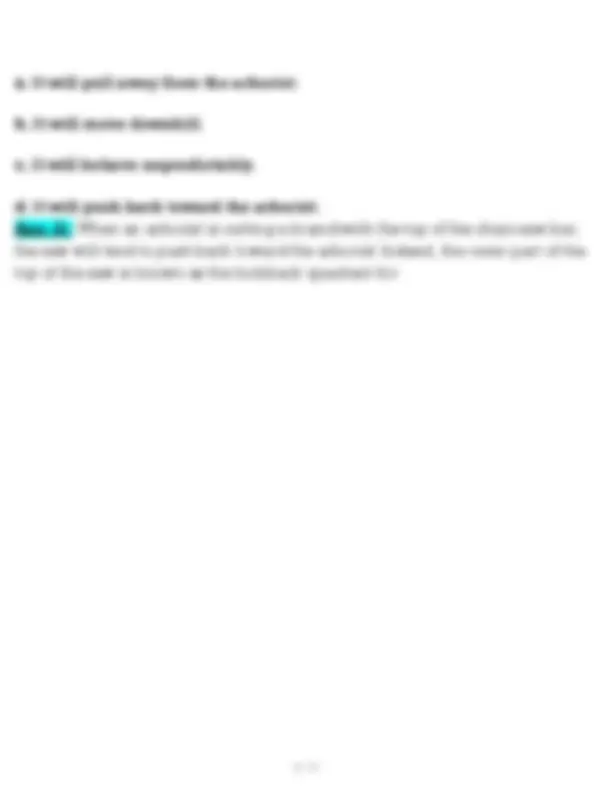
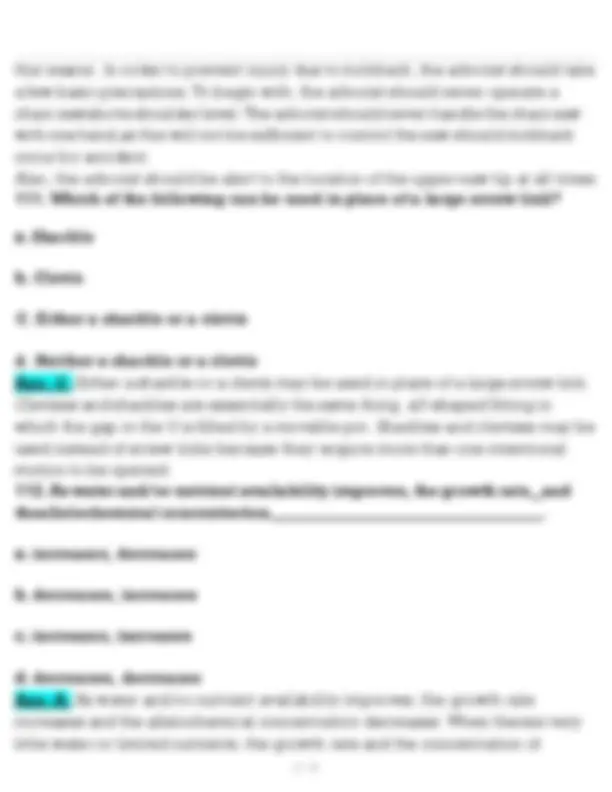
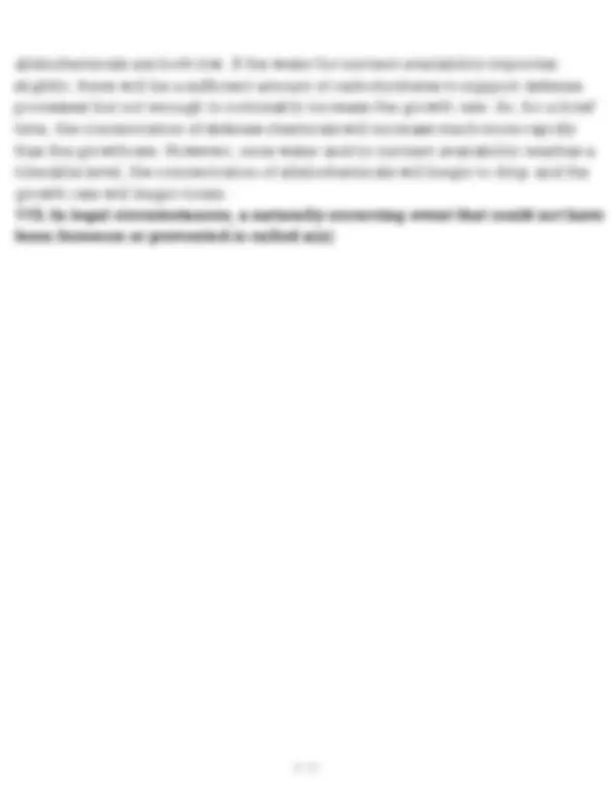
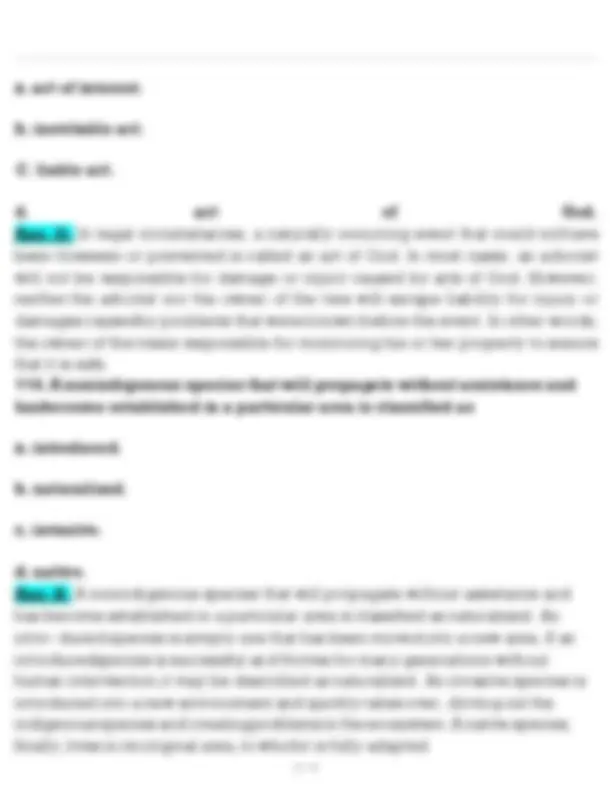
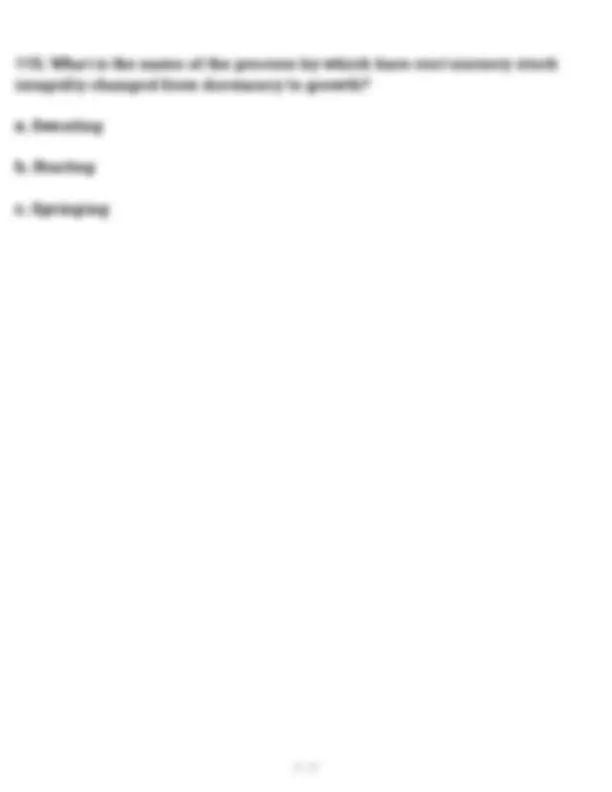
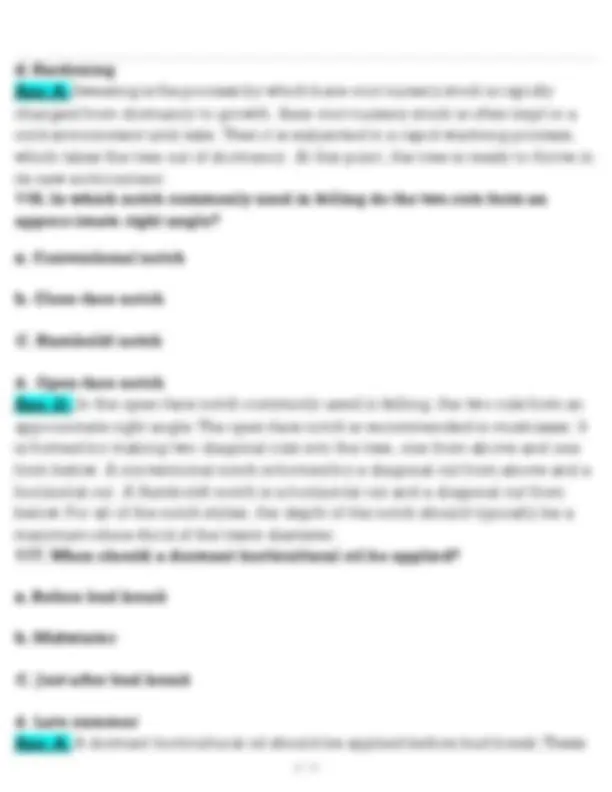
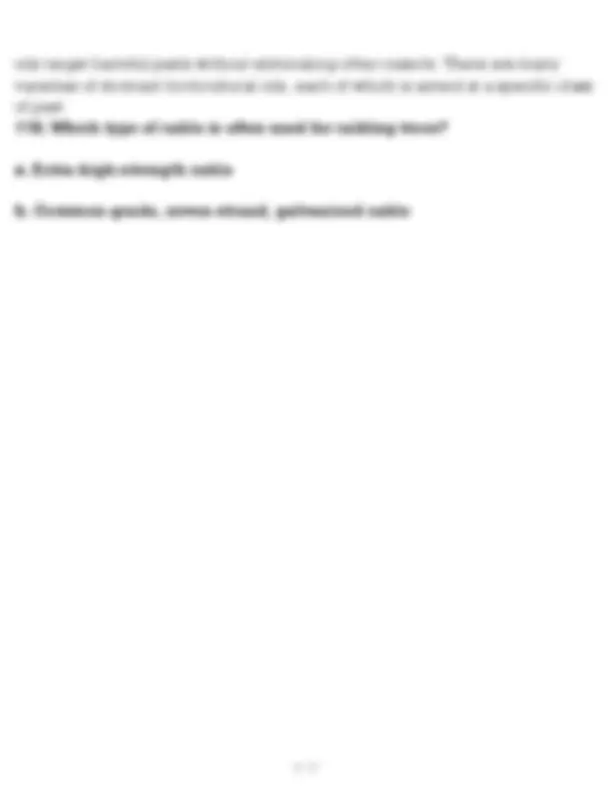
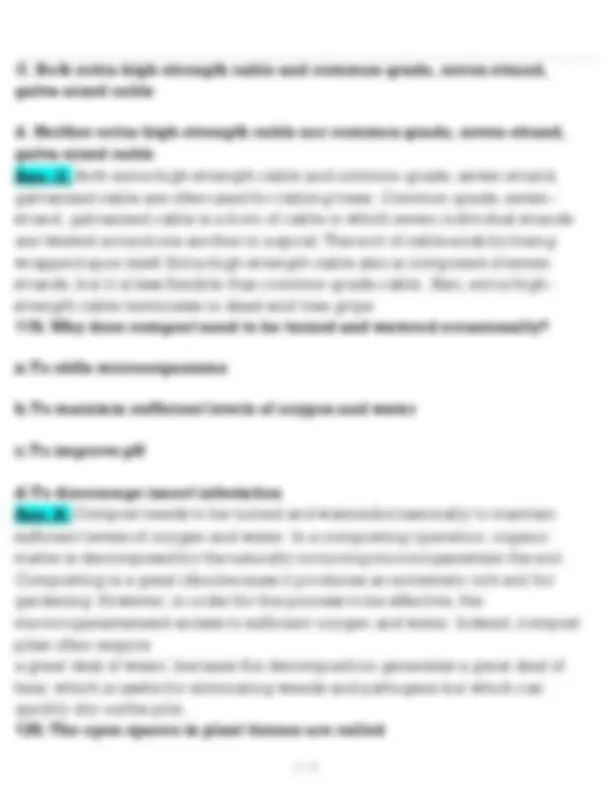
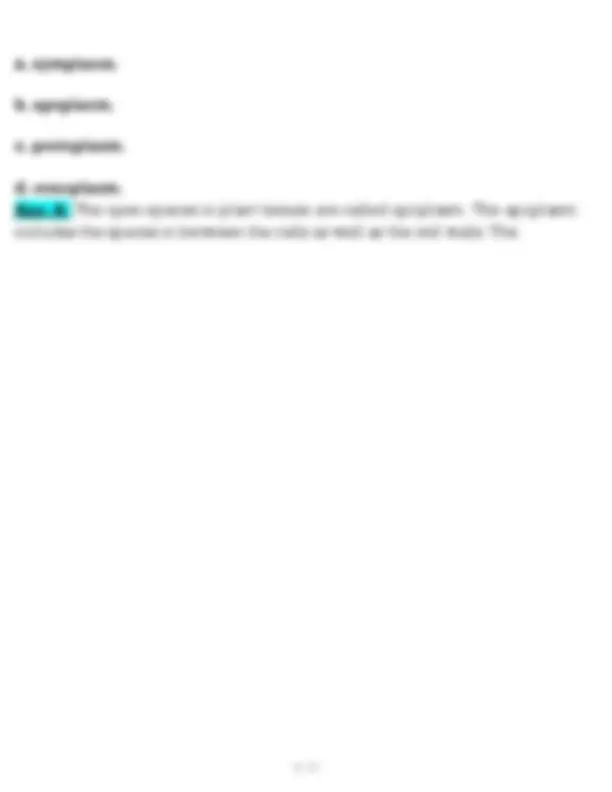
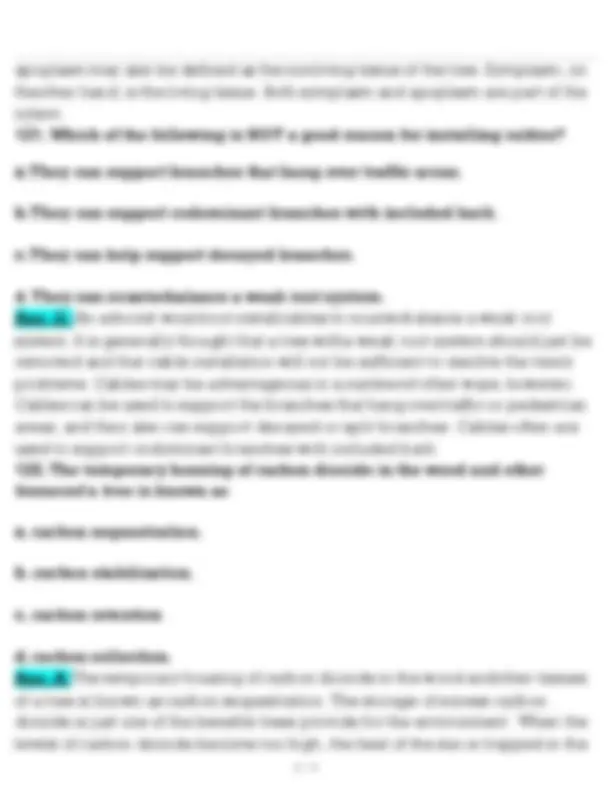
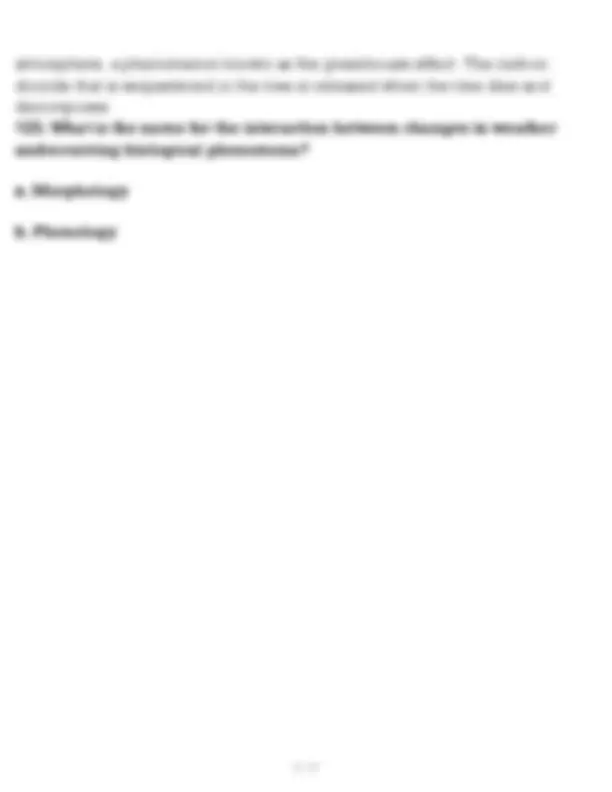
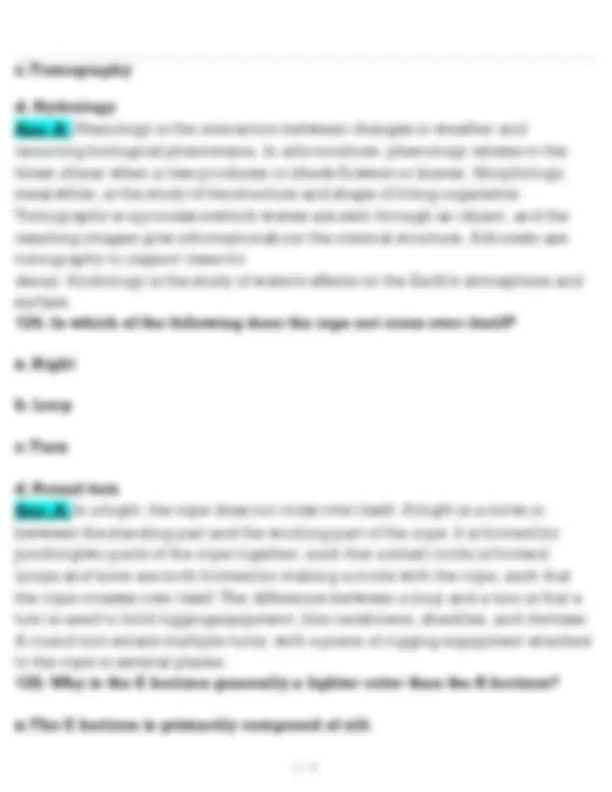
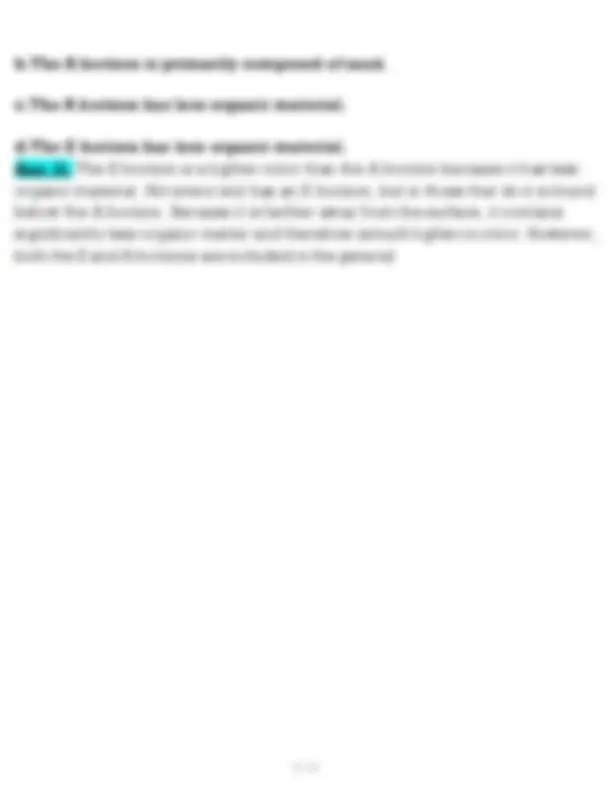
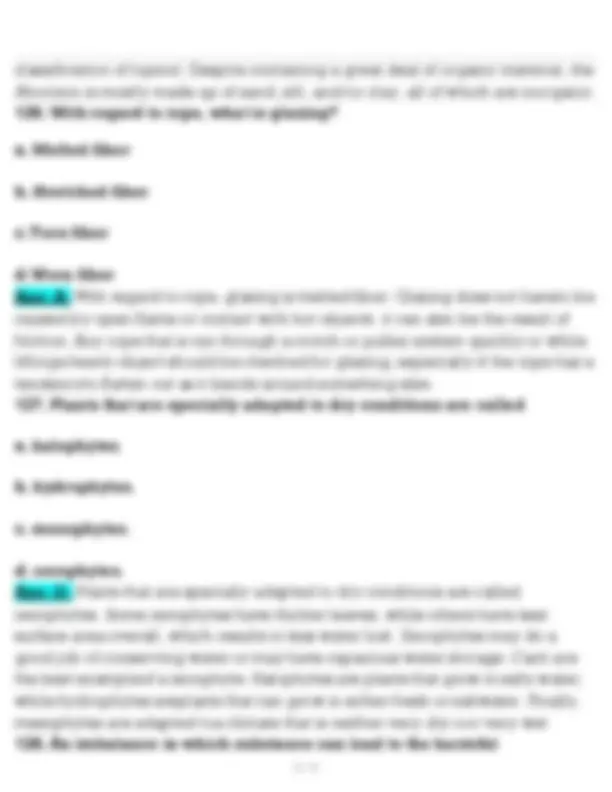
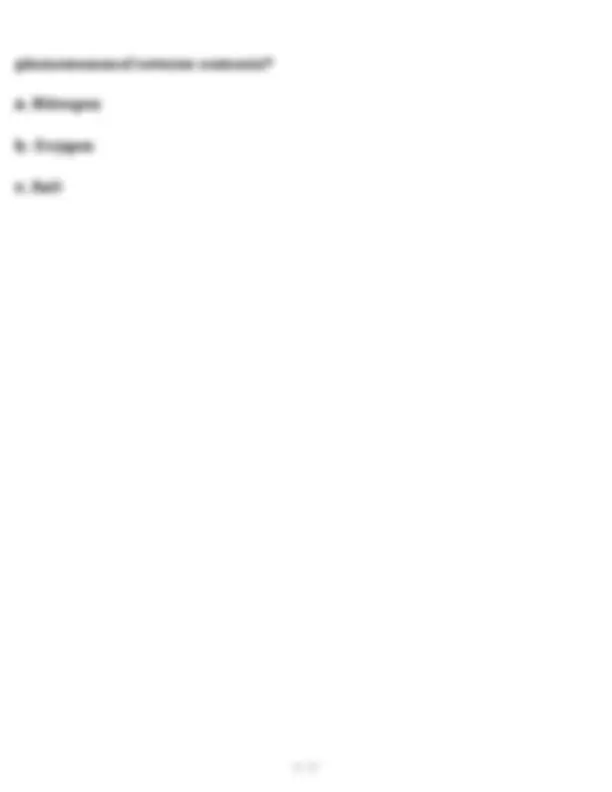
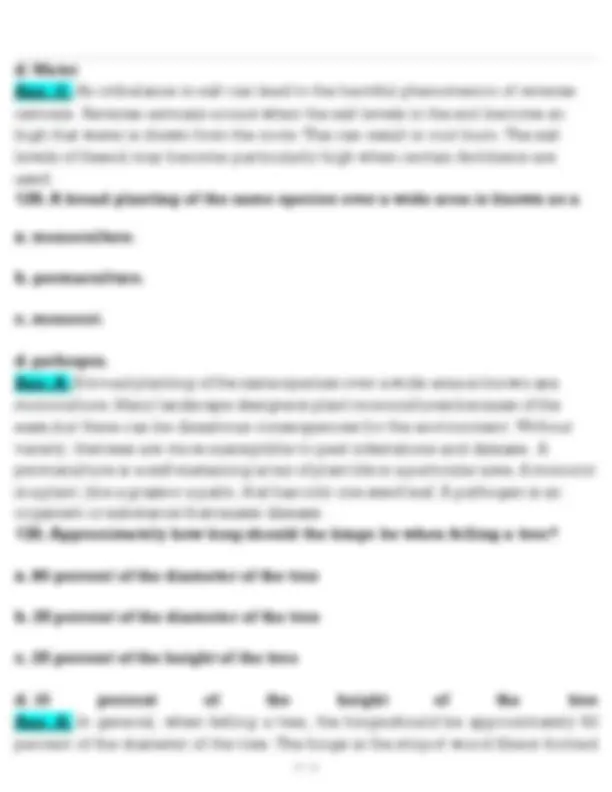
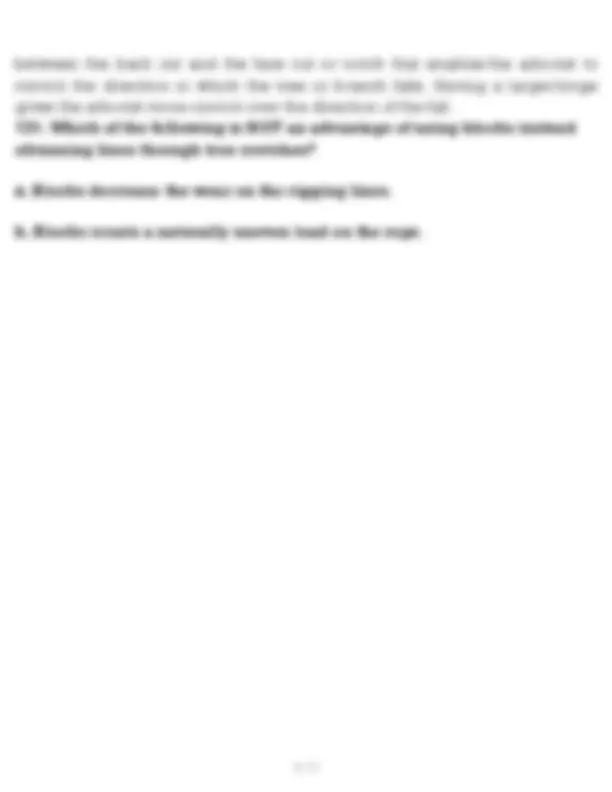
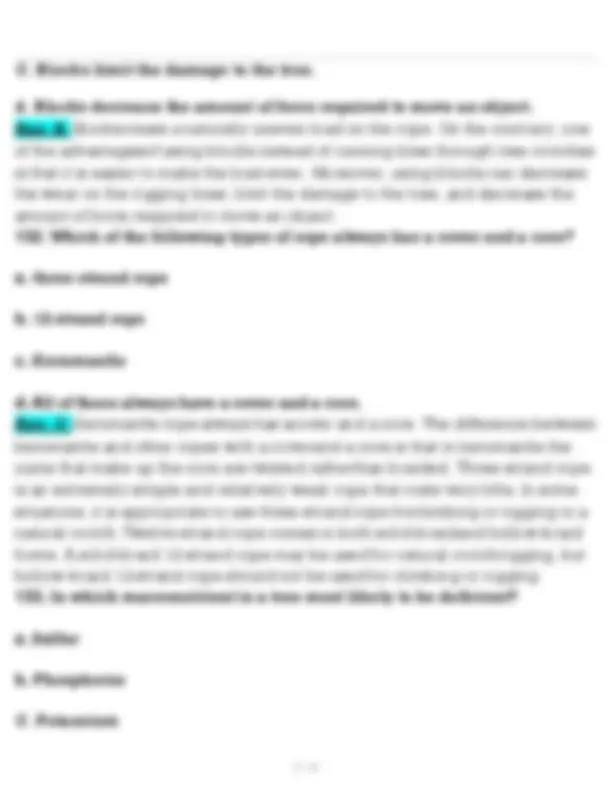
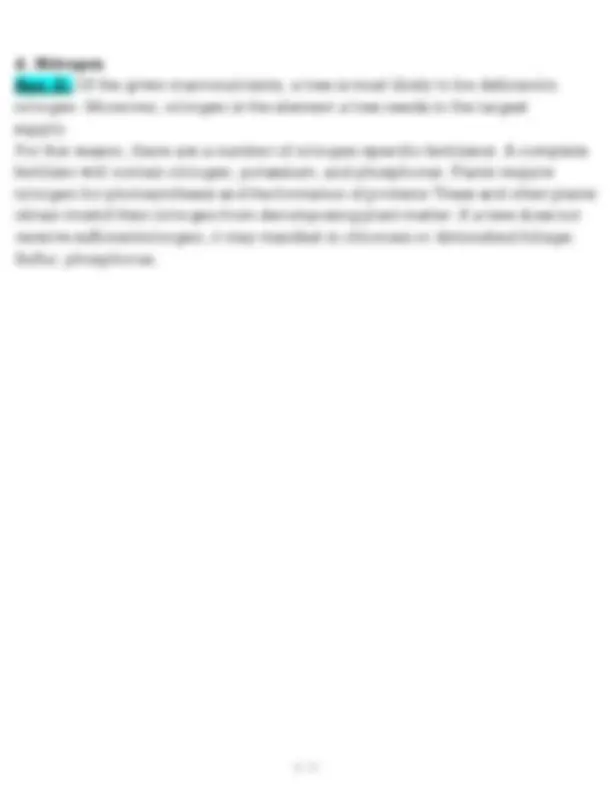
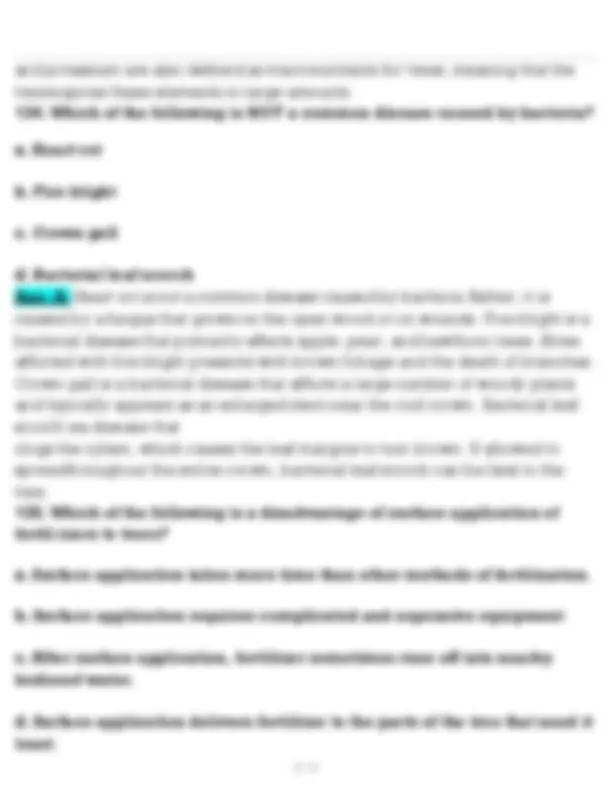
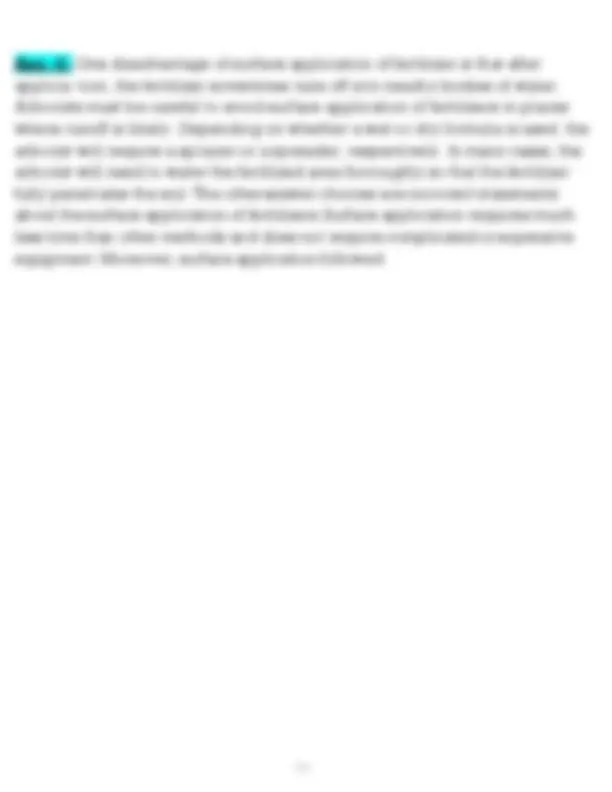


Study with the several resources on Docsity

Earn points by helping other students or get them with a premium plan


Prepare for your exams
Study with the several resources on Docsity

Earn points to download
Earn points by helping other students or get them with a premium plan
Community
Ask the community for help and clear up your study doubts
Discover the best universities in your country according to Docsity users
Free resources
Download our free guides on studying techniques, anxiety management strategies, and thesis advice from Docsity tutors
A valuable resource for individuals preparing for the isa certified arborist exam. it features numerous multiple-choice questions with detailed, rationalized answers covering various aspects of arboriculture, including tree felling techniques, pest management, plant care, and tree maintenance. The questions and answers are designed to enhance understanding and improve exam performance. This resource is particularly useful for students and professionals in the field of arboriculture.
Typology: Exams
1 / 154

This page cannot be seen from the preview
Don't miss anything!





























































































test consisting of 200 multiple-choice ques with Ans
1. In which direction should a chain saw operator move if he or she losescontrol of the tree while felling?
a. 45 degrees to either side of a line opposite to the intended direction of fall
b. In a line opposite to the intended direction of fall
c. In a line perpendicular to the intended direction of fall
d. Along the intended direction of the fall
Ans: A: If a chain saw operator loses controlof the tree while felling, he or she should move along a line 45 - degrees to either sideof a line opposite to the intended direction of the fall. Moreover, there should not beany other people in the area immediately behind the tree. Many arborists keep fellingwedges on hand while the back cut is being made. If necessary, these wedges canbe useful for keeping the tree from pinching the bar of the chain saw. Arborists canalso use felling wages to begin and control the fall.
2. On which side of a tree should workers stand while limbing or bucking?
a. The right side of the tree
b. The left side of the tree
c. Uphill from the tree
d. Downhill from the tree Ans: C: Workers should stand uphill from the tree while limbingor bucking. This is to prevent the tree from rolling over on the worker. In some cases,the arborist will need to use a wedge or a block to keep the tree from moving. When multiple workers are limbing or bucking the same tree at the same time, they need to be in constant communication, and should have a pre-established system for approaching or alerting one another. Limbing is the process of cutting the side branches off a tree that has been felled. Bucking is the process of cutting a tree trunkor log into shorter sections that are easier to manipulate.
3. Groups of different plants that need roughly the same amount of water arecalled
a. hydrozones
b. aquasets.
C. drought zones.
d. xeriscapes. Ans: A: Groups of different plants that need roughly the same amountof water are called hydrozones. Arborists often arrange trees in hydrozones so that watering is easier and less confusing. In addition, when there are variations in elevation at a particular site, the arborist may place trees that need more
height. Besides being aesthetically unpleasant, topping has a number of negative consequences for trees. First, topping drastically reduces the volume of the leaf crown, which makes it extremely difficult for the tree to produce enough food. Toppingalso makes the tree more susceptible to sun damage, disease, and insect infestation.Finally, topping encourages the growth of numerous weak sprouts from the top of
the tree. These water sprouts, as they are known, can put a significant burden onthe tree's already-taxed nutritional resources.
6. Which of the following is NOT a common part of a biological control strategyfor pests?
a. Poison
b. Parasites
c. Predators
d. Pathogens Ans: A: Poison is not a common part of a biological control strategy for pests. In a biological control strategy, the arborist enlists the support of a pest's natural enemies, whether they are predators, parasites, or pathogens. The strategywill take one of three forms: introduction, conservation, or augmentation. That is, the controlling agent may be introduced to the environment so that it can reduce the population of the pest; the existing population of controlling agents may be supported; or the existing population of controlling agents may be supplemented withorganisms from the lab or other natural environments. There is an obvious appeal to the idea of using natural means to handle pests, but biological control strategiesoften are slow and require a great deal of oversight. Moreover, it can be difficult to undo the effects of a biological control strategy.
7. What is the name for a large, irregularly shaped area of dead tissue on a leaf?
a. Dieback
b. Leaf blotch
b. Soluble potash
c. Phosphoric acid
d. Total nitrogen Ans: A: Potassium phosphate is not a standard part of the fertiliz-er analysis printed on the container. The standard fertilizer analysis includes a breakdown of the total nitrogen, available phosphoric acid, and soluble potash. These quantities are given as a percentage by weight: for instance, a 50-pound bag of fertilizer listed as 8-5-4 will contain 8 percent nitrogen (4 pounds), 5 percentphosphorus (2.5 pounds), and 4 percent potassium (2 pounds). Complete fertilizersare useful in some cases, but most trees only require nitrogen fertilizer.
10. With respect to the pull of the cable, in which direction should hardwarebe installed?
a. It does not matter.
b. Diagonally
c. Perpendicularly
d. Along the same line Ans: D: Hardware should be installed along the same line as the pull of the cable. This arrangement maximizes the strength of the hardware. If the cable pulls on the line at an angle, the forces exerted on the hardware will be asymmetrical, and therefore the hardware will not be able to function at its optimalstrength.
11. When should plants that bloom on the wood from the previous season bepruned?
a. After the blooms are shed
b. After the first frost of the autumn
c. Just after they bloom
d. Winter Ans: C: Plants that bloom on the wood from the previous season should be pruned just after they bloom, ensuring that blooming buds are not removed from the plant. Although timing is important in the promotion or discouraging of flowersor fruit, it is less significant in the removal of dead, diseased, or broken branches,which can be removed at any time of year.
12. During construction, how far should the tree protection zone extend fromthe trunk of a young tree?
a. 1 foot for each inch of trunk diameter
b. Two times the trunk diameter
c. At least 3 feet
d. Phosphorus Ans: C: Calcium is not necessarily part of a complete fertilizer. A complete fertilizer must include nitrogen, potassium, and phosphorus. Indeed, the standard analysis on the side of a fertilizer container describes the amounts of totalnitrogen, available phosphoric acid, and soluble potash. It should be noted that a complete fertilizer is not always an appropriate remedy. For instance, there are manycases in which a tree is deficient only in nitrogen and will benefit more from a fertilizerthat focuses on this deficiency only.
15. Which of the following structures is commonly found when there arecodominant stems?
a. Branch protection zone
b. Branch collar
c. Branch bark ridge
d. Included bark Ans: D: Included bark is commonly found when there are codominant stems. Included bark develops between the stems as bark is pinched between the two growing branches. The presence of included bark makes the branches weaker and can lead to a greater risk of failure in the future. The branch protection zone,
meanwhile, is a chemical and physical barrier between the stem and the trunk. A branch protection zone can prevent disease or decay within the branch from reaching the trunk, but it is usually absent when there are codominant stems. A branch collar is an enlarged area at the base of a branch, formed by the overlappingof the branch and trunk bark tissue. The branch collar provides extra support for the branch. A branch bark ridge is a strip of bark atop the branch union, created bythe growth of the trunk or the parent stem. Again, this structure will provide extra support, but it is either absent or ineffectively formed when there are codominant stems.
16. Which type of fertilizer is recommended for newly planted trees?
a. Complete fertilizer
b. Liquid fertilizer
c. Injection fertilizer
d. Slow-release nitrogen fertilizer Ans: D: Slow-release nitrogen fertilizer is recom- mended for some newly planted trees to encourage root exploration and to providea steady low-salt nutrient source for establishing trees. Generally, most trees do notneed supplementary fertilizer to thrive unless there exist soil conditions that are low in certain nutrients or nutrients are tied up in a form that makes them unavailable tothe plant.
17. The greenhouse effect is caused by excess amounts of in the atmos-phere.
a. nitrogen
b. carbon
c. oxygen
a. Crown restoration
b. Crown thinning
C. Crown reduction
d. Crown cleaning Ans: A: Crown restoration may be used to correct the problemscreated by topping. To restore a crown, the arborist will remove water sprouts, dead branches, and stubs. The arboristwill select a few strong branches to be the permanent branches of the new crown. The restoration process does not occur at once: the arborist usually must return to the tree several times over a period of years in order to make the right pruning decisions. Crown cleaning, meanwhile, is the removal of weak, dead, diseased, orbroken branches from the tree crown. Crown thinning combines cleaning with theremoval of some healthy branches to aid with light infiltration and airflow in a tree canopy. Crown thinning is used mostly for orchard trees and is no longer recognizedby ANSI A300 pruning standards as a regular pruning specification for landscape trees. Crown reduction is meant to diminish the overall size of the tree. To reduce the crown, the arborist will cut major limbs back to strong laterals or all the way to the point of origin.
19. How should the back be positioned when moving a heavy object from theground?
a. The back should be hunched.
b. The back should be held in a normal position.
C. The back should be held straight.
d. The back should be twisted. Ans: B: When moving a heavy object from the ground,the back should be kept in a position of comfort above the lower part of the body. It was long recommended that the back be straight when lifting heavy objects, but recent research has suggested that it may be better to maintain a normal posture, at least in terms of back curvature. Some researchers believe that paying too closeattention to the curvature of the back makes people lift primarily with the back ratherthan the legs, which is a more serious error.
20. In a soil profile, what is the top horizon?
a. B
b. 0
c. A
d. C Ans: B: In a soil profile, the 0 horizon is on top and is followed in descending orderby the A, B, and C horizons. A horizon is a layer of soil. The o horizon is primarily composed of decomposing organic matter. The A horizon contains sand, clay, andsilt and is darker than the layers beneath. The B horizon is a mixture of organic material from above and parent material from below. The Chorizon is where soil iscreated from the parent material. The Chorizon lies just above the bedrock.
21. What factor determines the height of the lowest permanent branch duringstructural pruning?
a. Location of the tree
b. Intended function of the tree
c. Both location and function
d. Neither location nor function
b. The working-load limit is higher than the tensile strength.
C. The working-load limit is the same as the tensile strength.
d. The working-load limit is unrelated to the tensile strength. Ans: A: The work- ing-load limit of a rope is always lower than its tensile strength. The working-loadlimit is the largest load a rope, piece of equipment, or rope assembly should bear during normal operation. The tensile strength of equipment or rope is the lowest force under which failure will occur during normal operation and with a staticload. Working-load limit is calculated by dividing the tensile strength by the design factor. The design factor of rope or equipment is a number representing the effectsof the particular conditions in which the rope will be used. A high design factor indicates poor conditions, while a low design factor indicates minimal friction and a clean workspace. The standard design factor for arboriculture work under normalconditions is five.
24. A turgid leaf is
a. dehydrated.
b. fully hydrated.
c. serrated.
d. bipinnate. Ans: B: A turgid leaf is fully hydrated. If the tree is healthy, the leaves should always be turgid in the early morning, even during the hottest part of the year. However, if the tree is dehydrated, the leaves may begin to curl up or yellowslightly.
25. Cytokinins are produced in the but are crucial for the growth of the.
a. shoots, roots
b. roots, leaves
C. roots, shoots
d. shoots, trunk Ans: C: Cytokinins are produced in the roots but are crucial for the growth of the shoots. These hormones are in many ways the counterpart to auxin,which is produced in the shoots but is an essential part of root growth. Cytokinins encourage cell division in the shoots.
26. The slow process through which a tree becomes accustomed to variationsin its environment is called?
a. acclimation.
b. aggregation.
c. hardening off.
d. selection. Ans: A: The slow process through which a tree becomes accustomedto variations in its environment is called acclimation. Any tree that is to survive conditions unlike those where it originates will have to acclimate. Aggregation, on theother hand, is a gathering together, as of soil particles. In arboriculture, hardening off is the process by which the outermost plant tissue adjusts to a new, often colderenvironment.
27. What percentage of an ideal soil is made up of mineral solids?
a. 10 percent
b. Midline clove hitch
c. Figure-eight knot
d. Endline clove hitch Ans: B: The midline clove hitch is primarily used for sending equipment up to a climber. It is popular for this purpose because it can be rapidly tiedin the bight of a line. The running bowline, on the other hand, is more often used intying off limbs. The running bowline acts like a slipknot, in that it can be sent up a lineby a person at the end. Moreover, even after it has been loaded, the running bowline is still easy to untie. The figure-eight is a quick and easy stopper knot. Finally, the endline clove hitch is primarily used to secure limbs or trunk pieces. It is an easy knot to master.
30. What is the typical treatment for highly sodic soil?
a. Application of slow-release fertilizer with low nitrogen content
b. Application of slow-release fertilizer with high nitrogen content
C. Irrigation with high-sodium water
d. Irrigation with low-sodium water Ans: D: The typical treatment for highly sodic soilis irrigation with low-sodium water. A sodic soil has too much of the cation sodium in its cation exchange capacity. Irrigation with low-sodium water will effectively rinsethis cation out of the soil. If the soil is not treated, it could lead to elevated pH levels,nutrient imbalances, crusting, and even sodium levels that threaten some plants. If irrigation with low-sodium water does not work, an arborist may need to add calciumto the soil, typically through the application of gypsum
31. What are codominant stems?
a. Two stems that feed from the same root
b. Two stems that intertwine
c. Two stems that are much larger than all of the other stems thatgrow from the same place
d. Two stems with roughly equal size that grow from the same place Ans: D: Codominant stems are two stems with roughly equal size that grow from the sameplace. Codominance is not a desirable trait, because the union between the stemsis typically quite weak. Codominant stems lack a branch bark ridge and do not forma branch collar. In other words, the area at the base of the stems is less fortified than it would be if there were a single dominant stem. Also, codominant stems aremore likely to have included bark, which is lodged between the stems, creating a structural weakness prone to failure.
32. Which of the following methods of starting a chain saw is NOT recommend-ed?
a. On the ground
b. Leglock method
c. Drop starting
d. All of these methods are recommended. Ans: C: Drop starting is not a recom- mended method of starting a chain saw. Drop starting is pulling the starter cord while pushing the saw away from the body. One reason why drop starting is not recommended is that it creates an opportunity for the operator to come into contactwith a moving chain. In the leglock method, the saw is positioned behind the right knee. This technique is sometimes used in favor of simply starting the saw with it lying on the ground, which is the safest method.
33. Which of the following components is NOT part of a lightning protectionsystem?